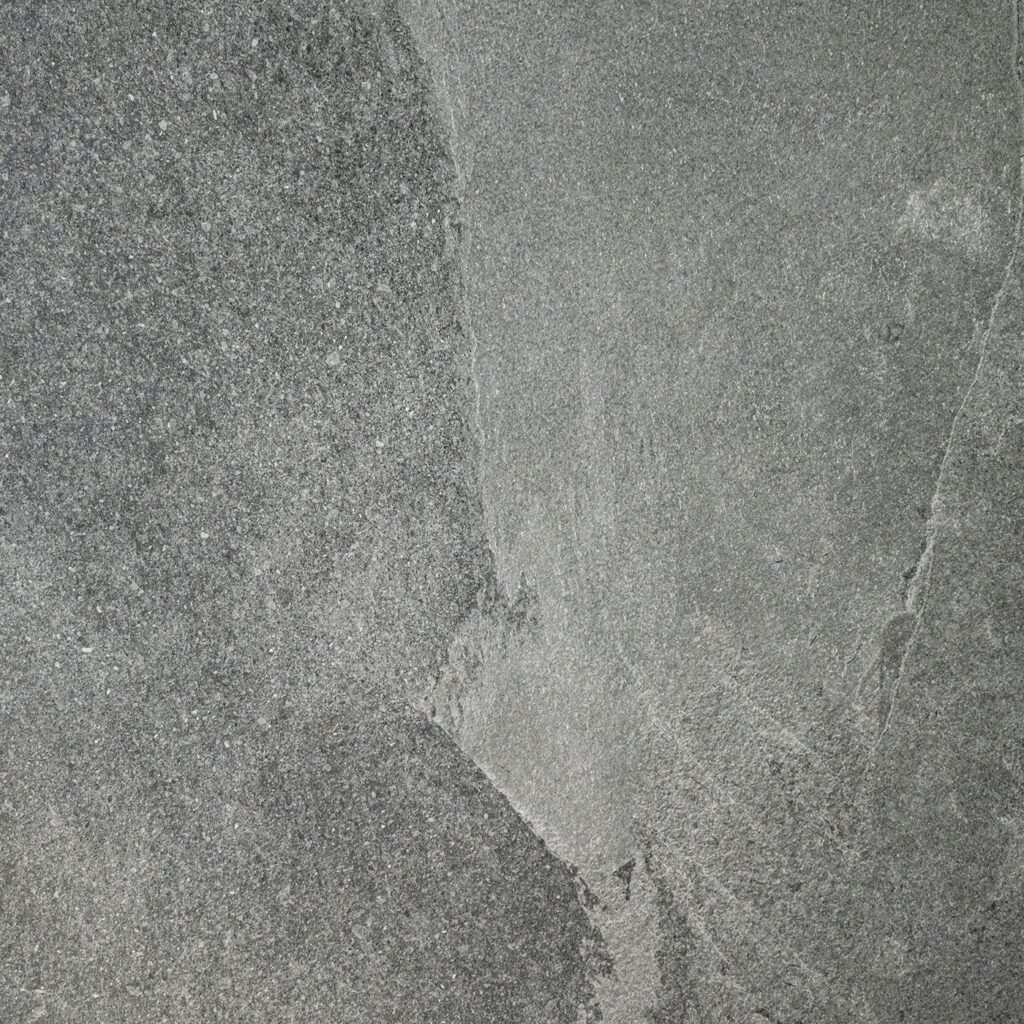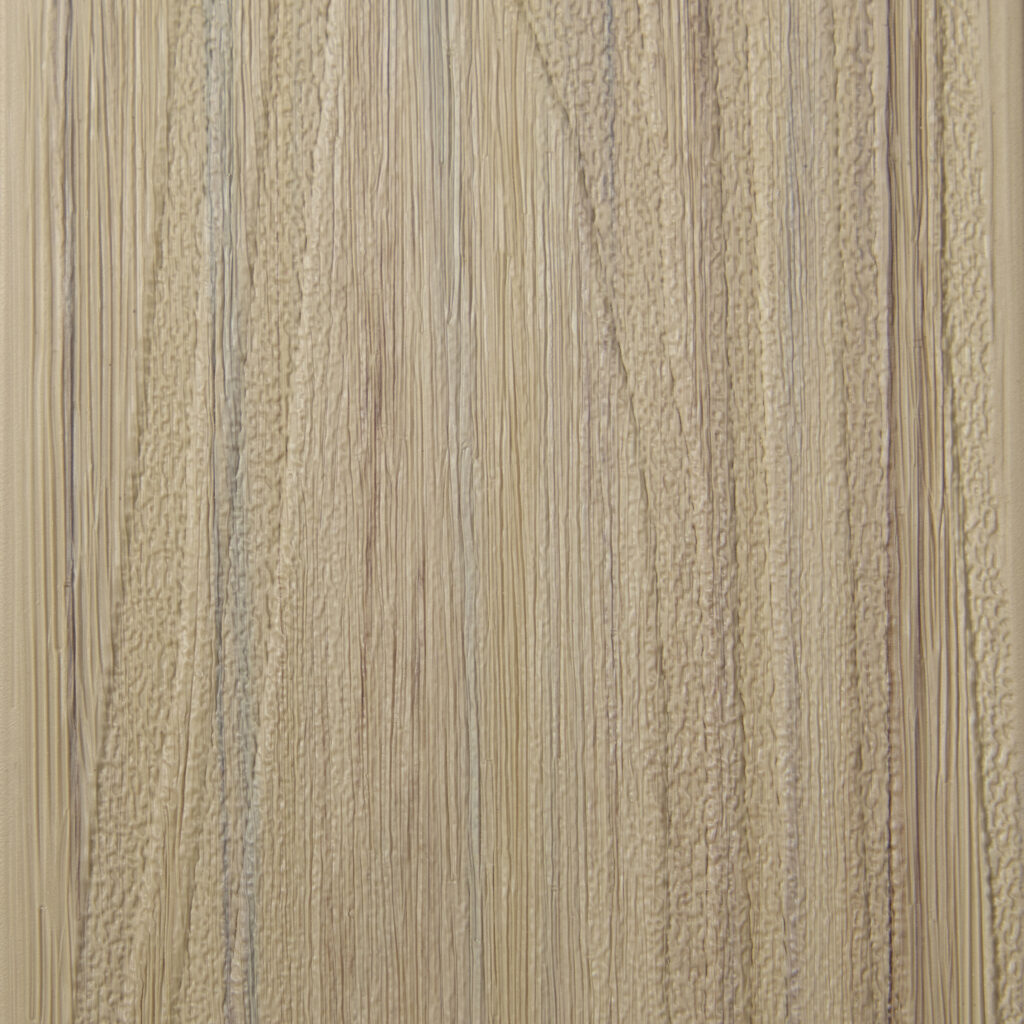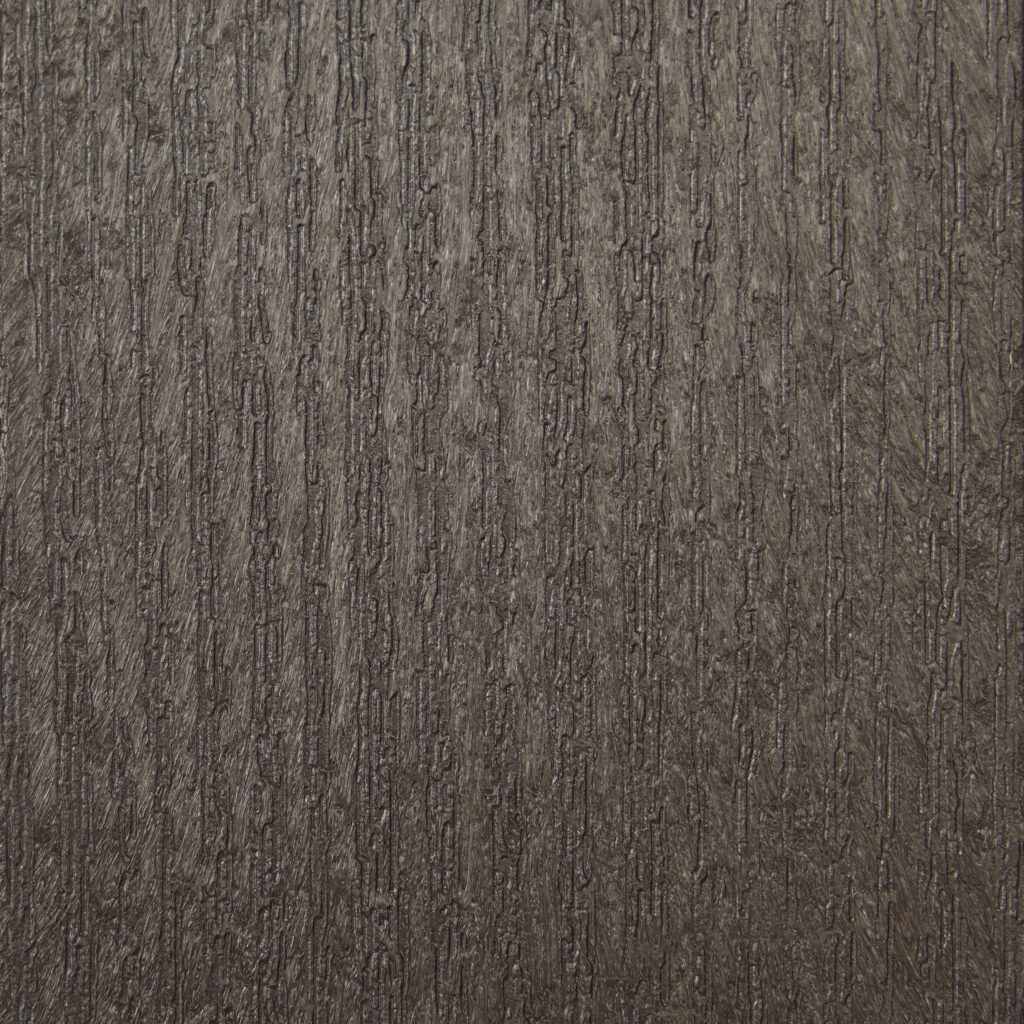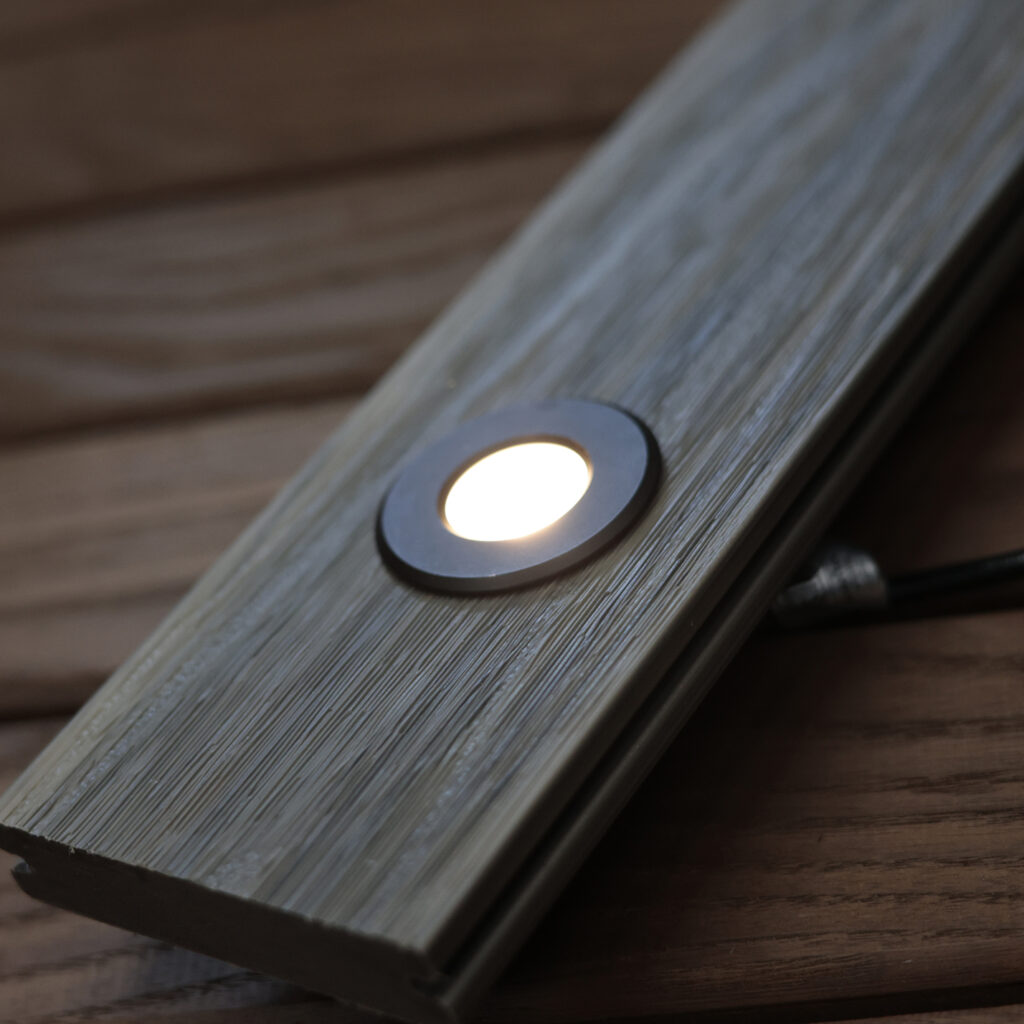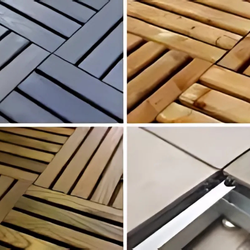- Mix N’ Match Deck Tile Ideas for Patios, Balconies, and Terraces
Are you in search of custom mix n’ match deck tile ideas? Do you want to renovate your outdoor spaces in a modern way by using different deck tiles and finishes? People are usually fond of mix n’ match tile flooring as it adds variety, texture as well as creative touch to patios, balconies and terraces. You can either pair porcelain tiles with grass tile inserts, wood composite decking with natural wood or even smooth ceramic tiles with rough stone textures for added contrast. For every outdoor space, there are several design ideas that will truly transform the look of your home. Let’s go through the best combinations to achieve a perfect mix n’ match deck tile look for your open space.
Various Mix N’ Match Deck Tile Ideas for Outdoor Spaces
As mentioned above, mix n’ match deck tile designs have become a smart way to upgrade outdoor areas of the home. Instead of sticking to a single style, people now blend different textures, colours, and patterns to create spaces that are both unique and visually appealing. At Designer Deck, we offer a variety of trending design ideas to help you transform your patio, balcony, or terrace. The options are listed below:
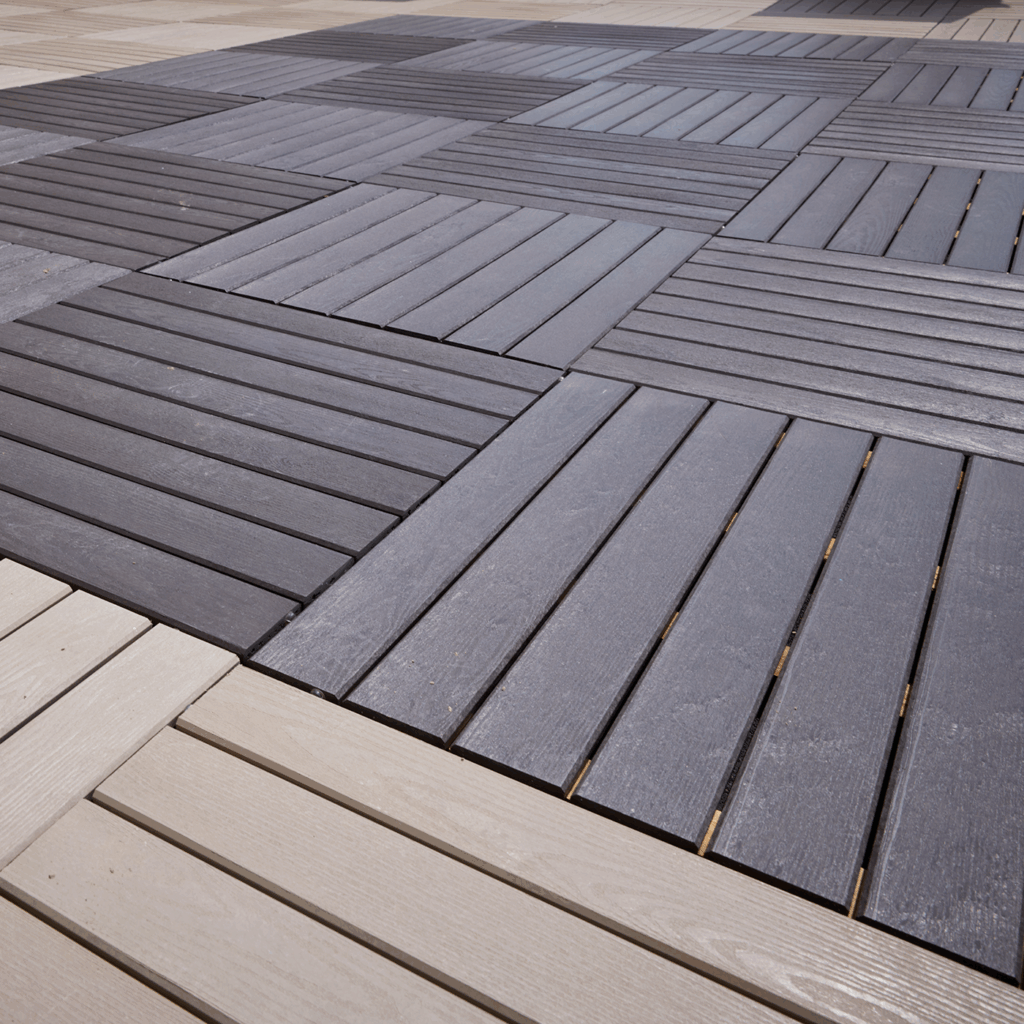
1. Combine Wood Tiles with Stone Surfaces
Pairing wooden tiles with stone surfaces is a great way to create a stylish and balanced outdoor space. Wooden tiles offer a smooth, natural appearance that feels comfortable underfoot, while stone tiles add roughness and depth to the overall design. When used together, they highlight different areas of your patio or balcony in a subtle yet creative way.
You can use wooden deck tile ideas in the sitting or lounge area and place stone tiles along the borders, around flower pots, or near walkways to create contrast. You can also try combining different tile shapes like square wooden tiles in the center. And, place long stone planks around them for a neat and modern layout.
2. Use Dark and Light Shades Together
Mixing light and dark tile shades is a simple design idea that can make your outdoor space look more dynamic and organized. Instead of going with a single tone, you can use light-colored tiles to brighten up open areas and dark tiles to add depth where needed.
For example, light shades can be used near garden edges or walkways to make the space feel open, while darker tones are good for under seating areas or around planters to give those areas a more grounded and defined look.
3. Mix Textured Tiles with Smooth Finishes
Combining textured tiles with smooth ones is a great way to enhance your outdoor space. Textured tiles such as stone-finish tiles or woodgrain-effect deck tiles have a rough surface that suits areas like garden corners, near pots, or around water features, where you want a natural, earthy feel and better grip.
On the other hand, smooth tiles like porcelain tiles, matte-finish WPC tiles, or polished composite decking tiles are perfect for walking paths or seating areas. They feel comfortable underfoot, are easy to clean, and make it simple to place or move furniture.
4. Try Diagonal Patterns for a Bold Look
Installing tiles in a diagonal pattern is a great way to make your outdoor space stand out. Instead of setting the tiles in straight rows, you install them at an angle, usually 45 degrees to create a bold and eye-catching layout. Start from the center or one corner of the deck and work your way out, making sure each tile lines up neatly to form a continuous slanted design.
This pattern works well in square or rectangular spaces and can make the area feel more open and creative. You can also stick to one colour for a clean finish or mix different shades and textures to add more interest. It is greatly ideal for broad balconies or narrow patios.
5. Combine Deck Tile Ideas with Natural Pebble Borders
For a calm, spa-like feel in your outdoor space, try combining deck tile ideas with natural pebble borders. You can install wooden or composite tiles in the main area and use smooth river pebbles to frame the edges. This creates a peaceful, Zen-inspired look that’s perfect for relaxing corners, patios, or garden pathways.
You can also use pebbles to design a small footpath between tile sections or to highlight features like plant stands or water pots. Choose white, black, or natural-toned pebbles based on the colour of your tiles to create a clean and beautiful contrast. It’s a simple design idea that adds both texture and calmness to your outdoor space.

6. Mix Porcelain Tiles with Grass Tile Inserts
If you want your outdoor space to feel fresh and close to nature, mixing porcelain tiles with artificial grass inserts is a great idea. Porcelain tiles have a smooth, clean surface that gives a modern look, while the green grass tiles add a soft, natural touch.
You can install porcelain tiles in larger blocks and place narrow strips or small squares of grass tiles in between. This creates a beautiful contrast of textures and colours, making your floor look more vibrant and inviting. It’s a smart way to bring greenery into your design without the upkeep of real grass, and it gives your space a cheerful, garden-like vibe.
7. Add Ceramic Accents to Deck Tiles
To create a boho or Mediterranean-style look, you can use plain deck tiles as the base and add ceramic tiles in between for a pop of colour and charm. These ceramic pieces can be hand-painted or patterned, placed either randomly or in a planned design.
This style works especially well on terraces with cozy seating areas or clusters of potted plants. The ceramic accents bring warmth and personality to the space, making it feel vibrant and thoughtfully designed without the need for extra decor.
8. Use WPC Deck Tiles with Natural Stone Textures
WPC (Wood-Plastic Composite) tiles are a great choice for outdoor areas like balconies and patios because they are durable, water-resistant, and easy to maintain. In contrast, natural stone tiles offer a more textured, earthy look that brings a raw, organic feel to the space.
You can create a smart and stylish layout by installing WPC Deck Tile Ideas in the main area especially where seating or furniture is placed, and using natural stone tiles along the borders or in specific corners. This mix adds both strength and contrast to your floor design. The smooth finish of WPC blends beautifully with the rugged surface of stone, giving your outdoor space a modern yet timeless appeal.
9. Add Metal Trims Between Tiles
If you are looking to give your outdoor flooring a sharp and elegant finish, adding metal trims between different tile types is a great idea. These trims, usually made of aluminum or brass, act as sleek dividers between materials like wood-look tiles, porcelain, or natural stone. They not only highlight the contrast between textures but also bring structure and clarity to the overall layout.
For example, if you are using warm-toned WPC tiles next to cool-toned stone or porcelain tiles, a thin metal strip can create a clean break that enhances both surfaces. The result is a well-defined, polished look that feels professionally designed.
Furthermore, you can also hire a Designer Deck expert for implementing your custom designs with precision and care.
Final Thoughts
Designer Deck is currently giving all customers a chance to register and enjoy 25% off on professional installation services. This includes expert help with measuring, planning, and properly installing your deck tiles whether you are using WPC, wood, porcelain, stone, or a mix of styles. Our professional installation ensures that every tile is placed evenly, securely, and with attention to detail. It is especially helpful if you are choosing custom layouts like diagonal patterns, mixed textures, or tile-and-pebble combinations. Begin your project, grab this special opportunity, save money and get your work done right.
- Innovative Decking Solutions: Why Modular Deck Tiles Are the Future
Need a modern approach for your outdoor flooring? Are you looking forward to innovative decking solutions that are easy to install and last for a long term? Then, modular deck tiles are exactly what you require. These tiles are designed as interlocking units made from materials such as wood, composite, or recycled plastic. You can fit them together seamlessly without the use for nails, glue, or any other complex tools. In this innovative world, modular tiles are perfect for renovating patios, balconies, terraces and so forth. Also, their simple installation process not only saves time but also reduces labor costs. Their simple installation process not only saves time but also reduces labor costs, making them a budget-friendly option for both homeowners and professionals alike. Let’s further discuss how modular tiles serve as innovative decking solutions in this fast-paced, ever-evolving world.
Modular Decking Tiles Setting A New Era for Outdoor Flooring
Outdoor living spaces have come a long way over the last decade. What used to be simple wooden decks or stone patios has now turned into something much more exciting. Today, several homeowners are preferring modern decking solutions that are resistant to extreme weather conditions, pests and are durable for a long time. One of the such popular trends are Modular tiles available in a wide variety of styles, patterns and colours. No matter what, if you are creating a brand-new outdoor haven or upgrading your current space. These tiles are quickly becoming the go-to choice for modern outdoor flooring as well as sustainable alternative to traditional decking.
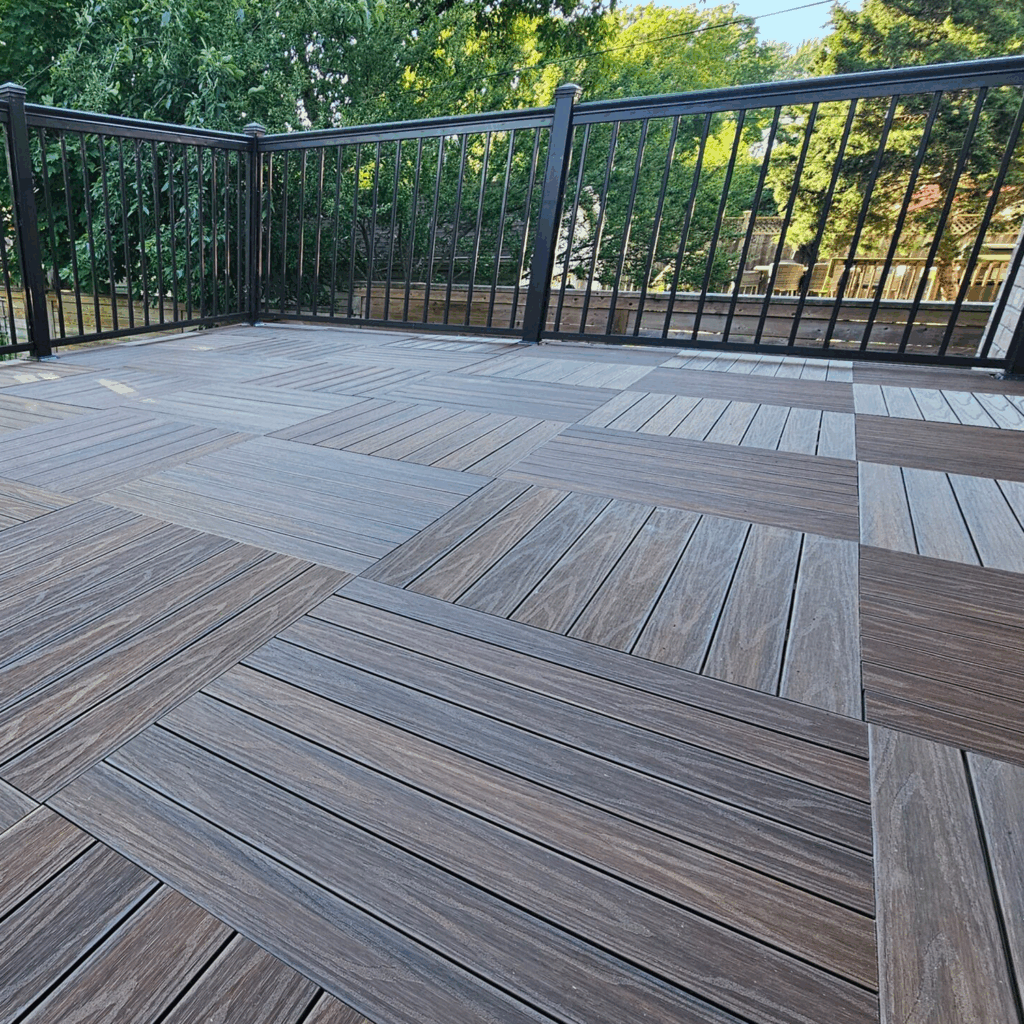
Explaining Why Modular Deck Tiles Are Gaining Popularity Nowadays
Well, there is no denying the increasing demand for modular tiles in outdoor spaces. So, what’s driving this shift? The key factors are convenience, durability, and aesthetics. Here are some reasons why modular tiles are quickly becoming the first choice for outdoor flooring:
1. Easy Installation
One of the biggest advantages of modular decking tiles is their ease of installation. Unlike traditional decking, the modular tiles are designed to interlock easily. You can install them in your outdoor spaces without any need for professional help or complicated tools. Just simply snap them together, and you have an instantly upgraded outdoor space. This user-friendly approach saves both time and money, allowing you to enjoy your newly renovated space.
2. Durability in All Weather Conditions
Modular decking tiles are designed to withstand various weather conditions, making them a great choice for outdoor spaces. These tiles are made from materials that resist moisture, extreme temperatures, and general wear and tear, which ensures that purchasing modular tiles is a good decision.
For example, composite tiles are highly resistant to moisture, ideal for areas that experience frequent rainfall or high humidity. They won’t warp, crack, or fade, even after being exposed to wet conditions for extended periods.
Similarly, recycled plastic tiles are built to last, holding up well in both hot and cold temperatures without cracking, splintering, or rotting. In any weather, modular tiles remain durable and reliable, keeping your outdoor flooring intact and looking good for years.
3. Low Maintenance Requirements
Unlike traditional wood decking, modular tiles require low maintenance. A simple cleaning with soap and water is usually all that’s needed to keep them looking fresh. It helps in saving your time, effort, as well as investment in the long run.
This is especially beneficial for busy homeowners who want a beautiful outdoor space without the ongoing upkeep of traditional materials. Moreover, the durability and resistance of modular tiles to common outdoor issues like mold, mildew, and pests make them a practical, worry-free choice.
4. Wide Variety of Styles and Designs
One of the main reasons modular deck tiles are becoming so popular is the wide variety of styles and designs they offer. Unlike traditional decking, which often comes in limited colours and materials, modular tiles are available in a range of textures, patterns, and colours. Whether you want a clean, modern look or a more natural, wood-like feel, modular tiles can help you achieve your desired style.
You can choose from wood-inspired finishes, stone patterns, or even bright, bold colours to complement your outdoor space. With so many options, modular tiles give you the freedom to create exactly the look you want, if you are going for a cozy, rustic vibe or a sleek, contemporary design.
5. Sustainability
Sustainability is becoming a significant factor in every aspect of life, including home improvement. Many modular tiles are made from recycled or eco-friendly materials like recycled plastic, making them a sustainable choice for those looking to reduce their environmental impact. This gives homeowners the satisfaction of knowing their outdoor flooring is not only stylish but also environmentally conscious.
Additionally, the ability to reuse and replace individual tiles, rather than tearing up and replacing an entire deck, reduces waste and the need for new materials. This makes modular tiles a more sustainable option compared to traditional decking materials.
6. Flexibility and Customization
Modular decking tiles offer great flexibility, allowing you to easily customize your outdoor flooring. Because the tiles are interlocking, you can arrange them in a variety of patterns and layouts to suit your space and style. If you ever want to change the design or move the tiles to a different area, it’s as simple as snapping them apart and reconfiguring them.
This flexibility makes modular deck tiles ideal for outdoor spaces that may change over time, such as patios that are used for different activities or areas that need to be reconfigured for different seasons. The ease with which you can modify and update the layout gives you more control over the design of your space.
7. Affordable and Cost-Effective
Compared to traditional decking materials like hardwood or stone, modular tiles are a more affordable option. The ease of installation means that you can save on labor costs, while their durability ensures you won’t need to replace or maintain them as often as other flooring options.
In addition, many modular tiles come with warranties, ensuring long-term protection and value for your investment. Over time, the cost savings on maintenance, repairs, and replacements make modular tiles a smart financial choice for homeowners.
8. Increased Property Value
Upgrading your outdoor flooring with modular decking tiles can also increase the value of your property. A beautiful, well-maintained outdoor space is a highly desirable feature for potential buyers, and modular tiles provide an elegant, modern look that can set your home apart. Furthermore, if you are planning to sell soon or just want to enhance the appeal of your space, modular tiles offer a cost-effective way to boost your home’s value.
9. Versatility for Various Outdoor Spaces
Modular deck tiles are incredibly versatile and can be used in a wide range of outdoor spaces. From patios and balconies to pool decks, rooftops, and even garden pathways, these tiles can be adapted to fit any area. Their interlocking design makes them easy to lay down on different surfaces, including concrete, grass, or existing flooring. This versatility means that you can create beautiful and functional outdoor spaces without worrying about uneven ground or needing special preparation.
Ultimately, modular decking tiles make it easier to create beautiful and functional outdoor spaces. Whether you are hosting a gathering, spending time with family, or just enjoying some quiet moments outside, these tiles provide support for all your outdoor activities.
Wrapping It All Up,
Designer Deck is the perfect choice for stylish and durable modular decking tiles. We understand the value of your time and money, which is why we focus on offering high-quality products that are easy to install and built to last. With our wide collection of exquisite outdoor custom designs, you can create an outdoor space of your dreams. Your outdoor space deserves the best, and with us, you can achieve the perfect balance, all while staying within your budget.
- Enhancing Your Home’s Aesthetics with Thermory Hardwood Cladding
Thinking about giving your home’s exterior a fresh new look? When it comes to home design, the exterior matters just as much as the interior decor, as it sets the first impression. Today, several homeowners are looking for long-term solutions to redefine the aesthetics of their homes. Among the various choices available, thermory hardwood cladding from Designer Deck stands out as a perfect option for reinventing your home’s aesthetics as well as design flair. This thermally treated premium hardwood is a good-to-go option as it is durable, resistant to rot and much capable of withstanding harsh weather conditions in extreme zones. Let’s see what more Thermory Hardwood Cladding has to offer and how it adds life to home’s overall design.
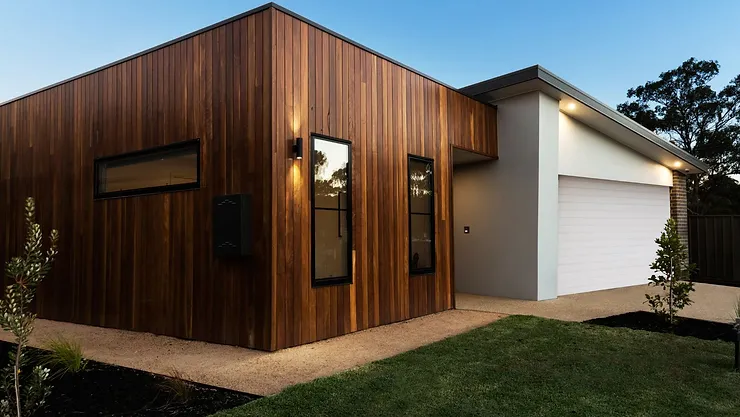
Restyle Your Home with Thermory Hardwood Cladding
If you are looking for real wood to modify the outside walls of your house, then thermory hardwood cladding is a great choice. This wood is naturally treated without the use of chemicals that generally enhances the wood’s strength and gives a stylish as well as natural look to your home.
Moreover, thermory hardwood cladding is capable of handling all kinds of weather and requires less maintenance. With such valuable characteristics, this premium wood is a reliable way to upgrade your exterior. Here’s how it’s a top choice for homeowners and designers alike.
1. Brings the Warmth of Nature to Your Exterior
Thermory hardwood cladding transforms the look of a home by adding the classic charm of natural wood. Unlike synthetic materials, this real hardwood offers rich, organic textures and warm tones that instantly make a home feel more welcoming. With such properties of this hardwood, its depth and warmth cannot be matched by artificial cladding products. It creates a cozy, natural ambiance that pairs well with outdoor greenery, gardens as well as scenic surroundings.
2. Elevates Modern and Contemporary Designs
Although natural, thermory cladding also works exceptionally well with modern architecture. The boards have a clean, refined look that aligns perfectly with minimalist and contemporary home styles. Whether you are working with flat-roofed designs, boxy structures, or sleek modern facades, the hardwood adds character without overwhelming the overall design. It adds contrast to geometric forms and sharp angles through its soft, wood grain texture and earthy colour.
3. Seamlessly Pairs with Other Building Materials
One of the greatest advantages of Thermory hardwood is its ability to blend effortlessly with various materials. Whether your home incorporates stone foundations, metal trims, glass panels, or concrete blocks, you can use these alongside for a balanced and harmonious appearance. For instance, pairing it with black steel and large windows gives an industrial-chic look, while combining it with stone brings a rustic, earthy vibe. This versatility makes it an ideal material for creative exterior designs.
4. Develops a Graceful, Even Patina Over Time
As Thermory wood is exposed to the sun and elements, it naturally weathers to a soft silver-grey patina. Patina is the natural colour change that makes wood or metal look more beautiful as it gets older. In case of thermory hardwood cladding, the aging process is smooth and even, enhancing the wood’s visual appeal over time. Unlike untreated wood that may fade unevenly or develop stains, Thermory maintains a consistent, elegant appearance.
5. Allows Creative Custom Designs
Another key point is that it is available in various profiles, widths, and installation patterns. And, this opens up a world of creative possibilities for homeowners. Whether you prefer a traditional horizontal plank look, a modern vertical design, or an eye-catching diagonal layout, thermory adapts beautifully. You can also combine patterns such as vertical panels on the front facade and horizontal on the sides to create a unique and visually captivating exterior that truly elevates your home’s appearance.
6. Enhances Outdoor Living Spaces with Cohesion
Outdoor areas like patios, porches, pergolas, and garden walls become more elegant when thermory cladding is used. It ties together indoor and outdoor aesthetics, creating a seamless flow between spaces. Using the same wood on an exterior wall and nearby patio enclosure, for example, can make the entire space feel like one unified, thoughtfully designed area that is perfect for entertaining guests or relaxing with family.
7. Adds Visual Depth and Texture to Walls
Flat exterior walls can sometimes look dull or lifeless, especially when made of plain concrete or stucco. Thermory hardwood cladding adds visual depth through its rich grain patterns and natural surface texture. It interacts with sunlight and shadows throughout the day, creating a dynamic facade that changes subtly from morning to evening. This constantly evolving visual texture gives the home a living, breathing character.
8. Perfect for Feature Walls and Architectural Highlights
Thermory hardwood cladding is also a great option to decorate feature walls or architectural highlights of your home. You can also use it to highlight the main entrance, add a beautiful touch to the upper floor, or frame windows and balconies with warm wood tones. These touches not only boost your home’s curb appeal but also give it a fresh, stylish look without needing a full renovation.
9. Can Be Used on Ceilings and Overhangs
Thermory hardwood cladding is also ideal for soffits, porch ceilings, balcony undersides, and entryway overhangs. Installing it on these often-overlooked surfaces helps create a fully cohesive exterior. It adds polish and elegance to the home, ensuring that every angle whether someone is approaching from the front or relaxing on the porch, has a finished and thoughtful design.
10. Great for Fences, Gates and Privacy Screens
For a complete and coordinated exterior, it can also be used to build fences, gates, and privacy walls. Using the same wood cladding material throughout your property enhances the visual consistency and makes the whole area look unified. A front fence or garden wall made with Thermory gives your outdoor space a polished, upscale look that matches the beauty of your home.
11. Increases Home Value and Curb Appeal
A home with a stunning wood exterior immediately stands out from the rest. Thermory cladding adds a touch of sophistication and elegance that not only looks amazing but also signals quality and durability to buyers. Because it is low-maintenance and long-lasting, it becomes an attractive feature for real estate listings, increasing your home’s resale value and making a positive first impression on potential buyers.
Additionally, thermory hardwood is treated without any harsh chemicals, making it a safe choice for families and pets. The wood is also sourced from responsibly managed forests, meaning you can enjoy beautiful cladding without harming the environment that is a major plus for eco-conscious homeowners. Though the hardwood cladding needs little maintenance, there are a few important points you should keep in mind.
Key Tips to Make Hardwood Cladding Last Longer
Thermory hardwood cladding is a reliable option and much worthy to spend money on it. To keep its performance intact for long-term, here are some key tips to know:
-
Ensure Proper Installation: Make sure the cladding is installed with enough ventilation behind it to prevent moisture buildup and related damage.
-
Clean Regularly: Gently clean the surface with mild soap and water to remove dust, dirt, or mold. Avoid harsh chemicals or abrasive tools.
-
Protect Against UV Damage: If you wish to retain the wood’s rich colour, consider applying a UV-protective finish to shield it from sun exposure.
-
Inspect Annually: Check the fasteners, joints, and seals every year to ensure they are still secure and in good condition.
-
Avoid Pressure Washing: Never use high-pressure washers, as they can harm the wood’s surface and reduce its lifespan.
-
Maintain Surrounding Areas: Trim plants and trees near the cladding to avoid trapping moisture and to allow better airflow.
Apart from this, you can also reapply finishes if needed depending on the climate. You can use protective oils as recommended by our expert team to keep the wood in good condition for a long time. For proper installation of thermory hardwood cladding, Hire A Designer Deck Pro to ensure successful home’s exterior transformation.
Conclusion
Designer Deck is a trusted brand recognized for offering premium thermory hardwood that enhance both the appearance and strength of your home. Whether you are planning a full exterior makeover or simply adding stylish touches with hardwood cladding, we offer a curated range of products that truly represent beauty, durability, and value in home design. With a strong focus on quality craftsmanship and affordable solutions, we make it easy for you to create a home exterior that truly stands out. Get ready to transform your home’s look, contact us today and bring your vision to life.
-
- Holiday Decorating Ideas for Small Deck Spaces
Planning to spend the holidays at home? Need creative ideas to embellish patio or deck spaces for a holiday retreat? Small deck spaces though limited in footprint, with well-planned design can be transformed into a cozy and charming spot. Whether you are celebrating your precious time with loved ones or enjoying a peaceful retreat alone, the right decorative elements can make your outdoor space a festive escape. Also, hanging twinkling lights, placing comfortable seating, plants, and other personal touches can make the space really enticing and inviting. In this blog, you will get to know several fun decorating ideas to help you make the most of every inch of your deck.
Creative Decoration Ideas for Small Deck Spaces
With so many options available to decorate outdoor spaces, it’s easy to feel overwhelmed. Choosing the right decorations that add both comfort and style can be a bit confusing. To make it simple, we have put together a list of easy and affordable decoration ideas to transform your space.
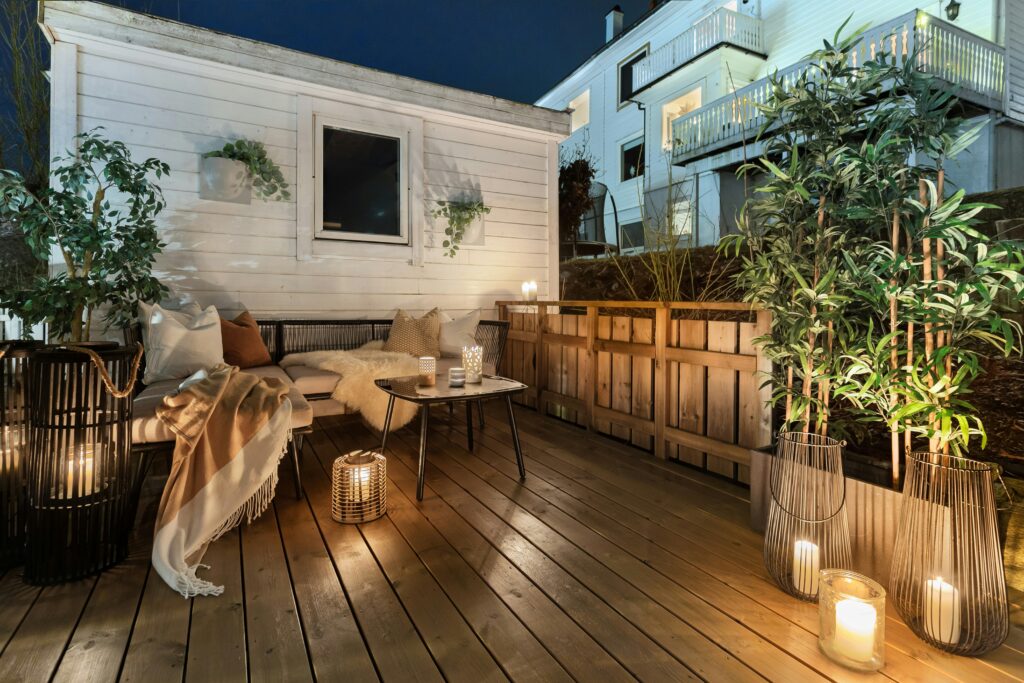
Moreover, using a little creativity and smart planning, your tiny outdoor area can become a cozy and cheerful spot for relaxing, entertaining, or simply enjoying fresh air. Here is the list below:
1. Set the Mood with Ambient Lighting for Small Deck Spaces
To make your deck space cozy and welcoming, use lights or other objects. Since small spaces require smart lighting choices, opt for ambient lighting that creates a soft, cozy glow without being overpowering.
- String Lights: Tie warm white or colourful string lights along railings, pergolas, or walls to add a charming glow.
- Lanterns & Candles: Use flameless candles in decorative lanterns to add a flickering glow without safety concerns.
- Wall Sconces & Hanging Bulbs: If you have walls or overhead space, install small sconces or try hanging Edison bulbs for a rustic, festive look.
A well-lit outdoor area instantly feels more welcoming, making it the perfect spot for relaxation or entertaining guests during the holiday season.
2. Optimize Seating for Comfort and Functionality
Limited space requires strategic seating arrangements that maximize comfort without overcrowding the area. The right seating choices can turn your deck into a cozy retreat.
- Foldable Chairs & Stools: These provide flexible seating options and can be stored away when not in use.
- Bench with Storage: A wooden or cushioned bench with built-in storage can hold blankets, pillows, or holiday decorations while providing comfortable seating.
- Floor Seating: Layer thick cushions, poufs, or an outdoor rug to create a relaxed and inviting space for lounging.
- Swing Chair or Hanging Hammock: If space permits, a small swing or hammock chair adds a fun and cozy element to the decor.
Adding soft, plush textiles like fleece throws and outdoor cushions in festive colours enhances the comfort and holiday feel of the space.
3. Add Seasonal Greenery for a Natural Touch
Bringing nature into your outdoor setting adds warmth, vibrancy, and a festive touch. Even small spaces can benefit from a little greenery.
- Mini Christmas Tree: A small potted fir or artificial Christmas tree can be decorated with lights and ornaments for an instant holiday upgrade.
- Garlands & Wreaths: Hang garlands along railings or place a wreath on the wall to enhance the festive look.
- Seasonal Plants & Flowers: Potted poinsettias, holly, pinecones, and dried orange slices make great natural decor elements.
- DIY Greenery Arrangements: Create a centerpiece with a mix of pine branches, eucalyptus, berries, and fairy lights for a rustic yet elegant touch.
Placing green plants not only elevates the holiday decor but also brings a refreshing outdoor ambiance to your deck. Must choose grass tile inserts for a fresh, natural look that adds warmth and charm to your outdoor space.
4. Utilize Vertical Space for Decor and Storage
When floor space is limited, vertical decoration techniques can help enhance the aesthetic without cluttering the area.
- Hanging Decorations: Hang ornaments, fairy lights, or small stockings on walls, fences, or overhead beams.
- Wall-Mounted Shelves: Install small floating shelves to display candles, festive figurines, or decorative mugs.
- Hanging Planters: Use wall-mounted planters with winter flowers or herbs to add charm without taking up extra space.
- DIY Holiday Banners: Handmade banners or chalkboard signs with holiday greetings can add a personalized touch.
By decorating upwards instead of outwards, you can create a visually appealing space while keeping the floor open and functional.
5. Create a Cozy Dining or Beverage Station
A dedicated spot for food and drinks adds functionality to your holiday deck decor. Even a small corner can serve as a charming dining or beverage station.
- Hot Chocolate & Coffee Bar: Set up a compact table or tray with holiday-themed mugs, marshmallows, cinnamon sticks, and warm drinks.
- Mini Dining Area: If space allows, place a small round table with two chairs, dressed with a festive tablecloth and candles.
- Snack Station: Use tiered trays or decorative baskets to hold holiday treats like cookies, nuts, and candy canes.
- Foldable Serving Cart: A mobile cart can store drinks, napkins, and holiday snacks while being easily moved when needed.
Adding small festive details like red-and-white straws, wooden serving boards, and holiday-themed napkins enhances the charm of the setup.
6. Layer Textiles for Warmth and Festivity
Soft textiles provide warmth and comfort, contributing to a festive and relaxed environment for the holiday season.
- Outdoor Rug: A weather-resistant rug in holiday colours or patterns can define the space and make it feel more inviting.
- Holiday Pillows: Swap regular cushions with seasonal designs like snowflakes, plaid, or reindeer prints.
- Table Runners & Napkins: Add a touch of elegance to tables with holiday-themed fabrics.
Furthermore, layering different textures not only enhances warmth but also adds depth and character to the space.
7. Play Soft Holiday Music for a Relaxing Ambiance
For more fun, play music to feel the holiday spirit and create a joyful, relaxing atmosphere.
- Bluetooth Speaker: A small portable speaker can play soft Christmas jazz, acoustic carols, or instrumental holiday tunes.
- Wind Chimes: For a natural musical element, hang delicate wind chimes with seasonal designs.
Keeping the volume low ensures a pleasant background ambiance without overpowering conversations or relaxation time.
8. Keep the Small Deck Space Simple and Clutter-Free
Overdecorating can make a small area feel cramped rather than festive. Keep it simple by choosing a few key pieces that improve the overall feel of the space without making it feel crowded or overly decorated.
- Choose a colour Theme: Pick a colour theme that suits the season, like traditional red and green, classy gold and white, or trendy blue and silver.
- Limit Decorations: Pick a few special pieces to highlight, rather than filling every corner with decorations. This keeps the space feeling open and stylish.
- Use Multi-Purpose Items: Opt for decor that also serves a function, such as storage benches, lighted planters, or decorative trays.
Conversely, keeping the setup neat and intentional ensures the space remains comfortable and visually pleasing.
Final Words
The holiday season is not about the size of your space but the warmth and joy you create within it. A small outdoor area can become a magical retreat with the right blend of lighting, cozy seating, festive decor, and personal touches of Designer Deck. Whether you are spending time with family or enjoying peaceful moments alone, your space should reflect the spirit of the season and bring happiness. Let the soft glow of lights, the comfort of warm blankets, and the beauty of greenery turn your deck into a place of celebration and relaxation.
- Designing a Pet-Friendly Balcony Using Durable Deck Tiles
Thinking of upgrading your outdoor nook into a pet-friendly space? Pets are our best friends, and caring for these companions is truly a genuine expression that comes straight from the heart. It often feels scary when your pet is running on a slippery balcony surface, as it might lead to serious or unwanted accidents. Also, homes with small outdoor spaces can be tricky for pets, especially when our furry fellows need comfort and extra safety. Pets usually prefer smooth spots where they can relax, stretch, and enjoy the fresh air. To express our care for pet owners, Designer Deck has the perfect solution. Our custom designed durable deck tiles are specially made with non-slip material and are completely pet-friendly. These tiles are durable, easy to clean, and gentle on your pet’s paws. Let’s learn more about these tiles, their types, and the installation process to create a simple and safe space that your pets will love.
Design Pet-friendly Balcony Using Durable Deck Tiles
When it comes to designing a balcony that’s both visually appealing and safe for pets, the choice of flooring plays a big role. Traditional flooring materials like concrete or ceramic tiles may look nice, but they can become highly warm under the sun, slippery when wet, or simply uncomfortable for your pet’s paws. Many pet owners choose deck tiles for their benefits and great materialistic look. Designer Deck’s durable deck tiles are made with high-quality materials that are built to withstand outdoor conditions while remaining gentle on paws. Their non-slip surface helps prevent accidents, giving you peace of mind when your pet is outside. Whether your pet enjoys lounging in the sun or playing around, these tiles provide a smooth and safe surface they can fully enjoy. A variety of deck tile styles and finishes are available to suit your outdoor space.
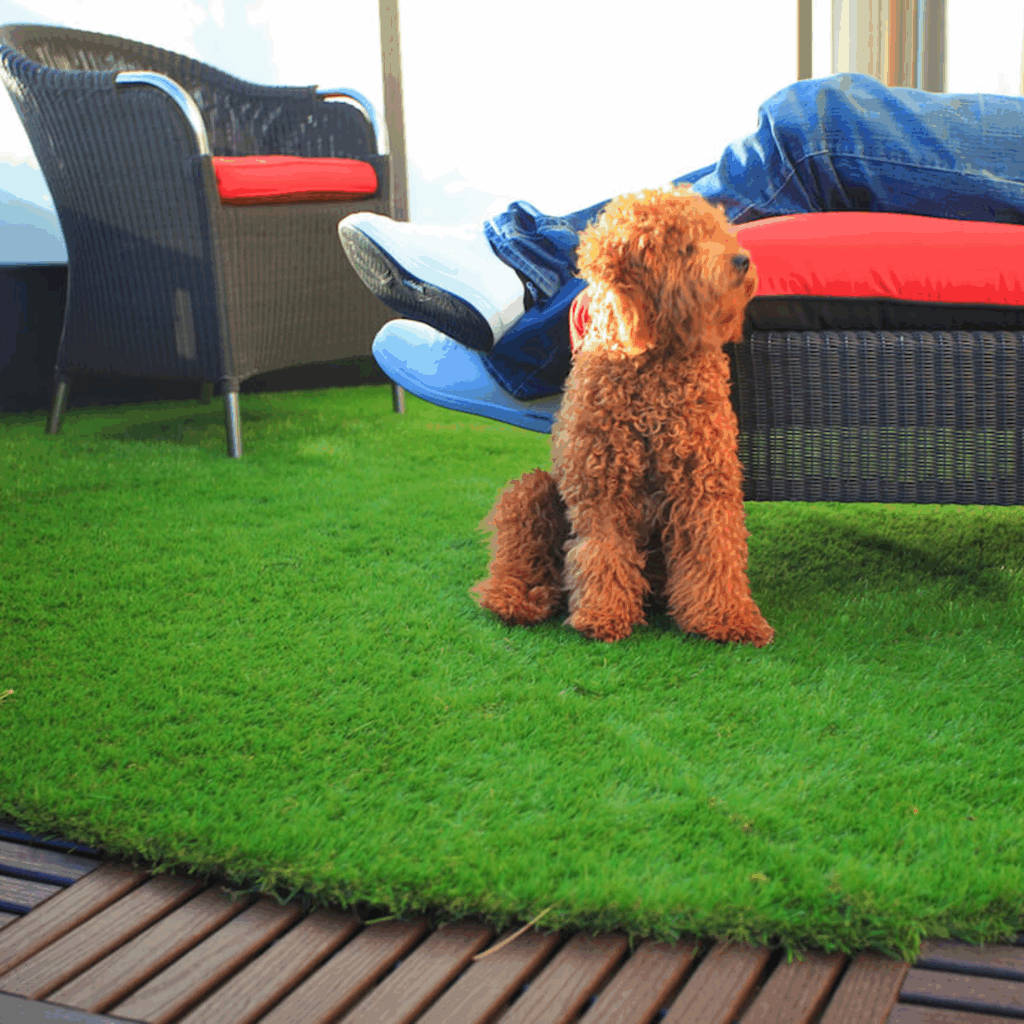
Various Types of Deck Tiles Suitable for Pets
At Designer Deck, we understand that every home and pet has different needs. We offer various deck tile options that are functional, safe, and stylish. Each tile type is thoughtfully designed to provide maximum comfort, durability, and safety for your four-legged friends.
1. Recycled Plastic Deck Tiles
These tiles are an excellent eco-friendly choice. Made from high-quality recycled plastic, they are tough, weather-resistant, and long-lasting. Their textured, non-slip surface makes them ideal for pets that love to run or move around. They’re also stain-resistant and easy to rinse off, perfect for managing dirt or paw prints.
2. Wood-Plastic Composite (WPC) Tiles
For those who love the look of natural wood but want something more durable, WPC tiles are a great fit. They combine the warmth of wood with the strength of plastic, offering a surface that won’t warp, splinter, or fade. Pets can walk, sit, or play comfortably on these smooth and splinter-free tiles.
3. Rubber Deck Tiles
Rubber tiles are soft, cushioned, and shock-absorbent, making them great for pets who are older, more active, or recovering from injuries. These tiles provide excellent traction, minimizing the risk of slips.
4. Interlocking Deck Tiles
All of our tile types come with easy interlocking systems. This feature not only makes installation quick and tool-free but also ensures that the tiles stay securely in place. This means no shifting or wobbling under your pet’s feet, which adds an extra layer of safety.
5. Drainage-Friendly Tiles
Some of our tiles are designed with built-in drainage channels, which prevent water from pooling on your balcony. This helps maintain a dry, clean surface for your pets and also protects the tiles from moisture damage.
Each option is crafted to ensure your pet’s comfort and your convenience. Whether you have a playful puppy, a calm senior dog, or a curious cat, you’ll find a tile type that meets your pet’s needs while enhancing your outdoor space.
Up next, let’s take a closer look at how easy it is to install these pet-friendly deck tiles and how to maintain them with minimal effort.
Step-by-Step Guide to Installing Durable Deck Tiles on Your Balcony
Installing durable deck tiles on your balcony is easy and quick. Just follow the simple steps listed below for a smooth and secure setup.
Step 1: Measure Your Balcony
Before purchasing deck tiles, measure the area to determine how many tiles you need.
Step 2: Choose the Right Deck Tiles
Select deck tiles based on your pet’s needs. If you have an energetic dog, consider using rubber or artificial grass tiles for a comfortable and durable play area. For a cat, composite or wooden tiles work well.
Step 3: Clean the Balcony Floor
Sweep and wash the balcony floor to ensure a clean surface before installation.
Step 4: Install the Deck Tiles
Many deck tiles feature an interlocking design, allowing for straightforward installation without the need for specialized tools or adhesives. Simply click them together like a puzzle, covering the entire floor.
Step 5: Secure the Edges
Use edge trims or barriers to prevent tiles from shifting, especially if your pet moves around a lot.
Step 6: Add Finishing Touches
Once all tiles are in place, you can put back your furniture, add pet beds, or lay out toys. Ensure your balcony offers sufficient space for your pet to move around comfortably and safely.
Furthermore, to help your deck tiles last longer, clean them regularly with a broom or a damp cloth. For a more thorough clean, use mild soap mixed with water, and check once in a while to make sure all tiles are still securely in place. Install these pet-friendly deck tiles requiring minimal maintenance and easy to remove or replace whenever needed for a fresh, polished look.
The Takeaway
Designing a pet-friendly balcony is a simple yet rewarding project. By using the right type of durable deck tiles, you create a space that is both safe and inviting for your furry companion. Adding small features like shade, toys, and water ensures your pet feels relaxed and cared for outdoors. Whether you have a curious cat or an energetic dog, your balcony can become a favorite hangout for both of you. With a few thoughtful Designer Deck’s choices, you can transform your balcony into a clean, cozy, and stylish sanctuary that your pet will love every day.
- Pressure-Treated Narrow-Board Wood vs. Composite Decking: Making the Best Choice for Your Deck
Selecting a decking material is an important decision that impacts the durability, maintenance, and overall look of your outdoor space. Homeowners often consider pressure-treated narrow-board wood and composite decking, two widely used materials with unique benefits. Wood offers a classic, natural appearance, while Designer Deck’s composite decking provides long-term resilience with minimal upkeep. Key factors such as cost, durability, maintenance, and environmental impact are crucial when selecting the ideal decking material. A well-informed choice ensures a deck that enhances outdoor living while providing lasting value. Understanding these differences helps homeowners invest in a deck that enhances their outdoor living experience while meeting their budget and maintenance preferences.
Pressure-Treated Narrow-Board Wood vs. Composite Decking
Pressure-treated wood is a common and affordable decking material made by infusing chemicals into the wood to enhance its resistance to moisture, insects, and decay. On the other hand, the composite decking is made from recycled materials and is preferred mostly for its longevity and good-quality. Let’s compare which product is right for you to renovate the outdoor spaces.

1. Cost Considerations
One of the biggest deciding factors when choosing decking material is cost. Pressure-treated narrow-board wood is a budget-friendly option upfront, making it an ideal choice for homeowners looking for a better way to build or replace a deck.
The initial cost of pressure-treated wood is lower than composite decking because wood is a natural resource that requires minimal processing. With regular staining, sealing, and potential repairs the expenses gradually increase as the deck ages.
Though the composite decking costs more at first, it saves money over time because it needs less maintenance.
To clarify, if budget is a primary concern, pressure-treated wood is the more affordable choice. But to reduce the after repair costs, we would recommend you choosing wood plastic composite over narrow-board wood.
2. Durability and Longevity
It is a critical factor in choosing a decking material. Special chemical treatments help wood resist decay, insect infestations, and water damage. However, it can still warp, crack, or splinter as time passes. Being naturally sourced, it expands and contracts with temperature shifts, potentially affecting stability.
In contrast, composite decking is built to endure tough weather conditions without deterioration. Made using recycled wood fibers and plastic, it withstands moisture, UV rays, and insect damage. Unlike wood, composite boards do not crack, split, or develop splinters, ensuring long-term durability with minimal wear and tear.
As a result, composite decking is the superior choice when it comes to durability and long-term performance. Also, investing in wood plastic composite is worth at it as it does requires only minimal maintenance, thus saving your money.
3. Maintenance Requirements
The level of maintenance required for a deck significantly impacts its long-term appeal and usability. Regular care is needed to keep pressure-treated wood in good condition and maintain its visual appeal. This includes sealing, staining, and repairing any cracks or splinters. Without proper sealing, wood can soak in moisture, which may cause mold and weaken its structure.
Composite decking offers a low-maintenance alternative to wood. Simply cleaning with soap and water is enough to preserve its look. Its non-porous surface prevents water absorption, making it resistant to rot and pests. Consequently, composite decking is a better option as it requires minimal upkeep.
Also, if you don’t mind occasional maintenance, pressure-treated wood can work, but it demands more attention. So, purchasing wood plastic composite decking will be a fruitful decision.
4. Aesthetic Appeal
Most of the homeowners consider the aesthetic appeal of a deck as an essential factor when selecting materials to renovate exteriors. Pressure-treated wood provides a natural and classic look that many people love. Natural wood can be customized using various stains or paints to reflect individual tastes. Over time, sunlight and moisture can cause the finish to fade, show flaws, or change colour.
Composite decking is available in various shades and finishes, with designs that mimic real wood. The main advantage of composite materials is that they retain their colour and finish for years without the need for repainting or refinishing.
Furthermore, if you want the flexibility to change the colour and appearance of your deck, pressure-treated wood is the better choice. If you prefer a deck that maintains its look without fading or discoloration, composite decking is ideal.
5. Environmental Impact
For environmentally conscious homeowners, the sustainability of the decking material matters. Pressure-treated wood is a natural resource, but the chemical treatments used to enhance its durability raise concerns about environmental impact. Some preservatives can leach into the soil, posing potential ecological risks.
Made using repurposed wood fibers and recycled plastics, composite decking supports sustainable construction. This reduces the demand for natural timber and minimizes landfill waste. Additionally, composite boards last longer, reducing the need for sudden replacements and lowering the overall environmental footprint.
For those who consider sustainability or saving the environment as a top priority, composite decking is the eco-friendly choice. Pressure-treated wood is renewable, but the chemicals used in it and its short lifespan, make it less environmentally friendly.
6. Safety Features
A deck should be a safe place for family and guests. Pressure-treated wood, while durable, can develop splinters over time, which can be a hazard, especially for children and pets.
Additionally, wood surfaces can become slippery when wet, increasing the risk of falls. On the other hand, composite decking is designed with safety in mind. It does not splinter, making it comfortable to walk on barefoot.
Composite boards are often designed with textured surfaces to enhance traction, helping to prevent slips and falls. Given that safety is a primary concern, it proves to be a dependable choice for families as well as pets.
7. Customization and Design Options
Pressure-treated wood is highly versatile, allowing you to paint or stain it in different colours to match your desired aesthetic. This allows homeowners to change the deck’s appearance over time. However, maintaining the chosen finish requires ongoing effort.
Composite decking comes in various colours and wood-like textures, but customization is limited to the pre-manufactured options. While it does not allow for staining or painting, it retains its original colour without fading, reducing maintenance.
If you want complete control over the deck’s colour and design, wood is the better option. For a hassle-free option with built-in colour choices, composite decking provides a durable and low-maintenance solution.
8. Weather Protection
Since decks are always exposed to outdoor conditions, their ability to withstand different weather is essential. Pressure-treated wood can withstand outdoor conditions but requires sealing and staining to prevent water damage, warping, or cracking. Without regular maintenance, it can gradually break down over time.
Composite decking is built to endure harsh weather conditions. It resists moisture, reducing the risk of rot, swelling, and mold growth. It also resists fading due to prolonged sun exposure, making it a durable option for areas with extreme weather conditions. In this case, choose a deck that can handle harsh weather without constant upkeep, and composite decking is eventually a better option.
9. Pest and Mold Resistance
Wood decks are prone to damage from termites and carpenter ants, which can gradually weaken them. Also, during the rainy season the wood can build excess moisture that can lead to the growth of mold and mildew, which means more maintenance is needed.
To tackle this problem composite decking is an effective solution. It withstands damage from both pests and mold. Since it is not an organic material, insects do not feed on it, and moisture does not cause decay. If you are looking for a deck that resists pests and mold without chemical treatments, composite decking is the best choice.
10. Resale Value and Investment
Keeping a deck in good condition can greatly boost a home’s resale value. Pressure-treated wood decks are attractive but require maintenance, which may concern potential buyers. Composite decking adds a modern, low-maintenance appeal that attracts buyers looking for durability and convenience.
Most homeowners prioritize long-term investment value when choosing decking materials. Composite decking provides a superior return with its durability and low-maintenance appeal.
Final Decision: Which One Should You Choose?
Selecting the ideal decking material depends on priorities, lifestyle, and budget. For those seeking affordability and a traditional look, pressure-treated narrow-board wood is a cost-effective option.
For homeowners prioritizing longevity, minimal upkeep, and modern aesthetics, composite decking is the superior choice. It withstands moisture, fading, and pests while remaining strong for years. Unlike wood, it stays intact without warping, cracking, or splintering, providing a safe and low-maintenance option.
With advanced durability, enhanced safety, and long-term cost savings, composite decking by Designer Deck outperforms wood in nearly every aspect. It is the smarter investment for a stylish and low-maintenance outdoor space that lasts.
- Top 5 Applications of Wood Plastic Composites in Modern Construction
Wood Plastic Composite (WPC) has entirely transformed the scenario of modern construction due to its durability and low maintenance requirements. The composite material combines wood fibers as well as thermoplastics that together create eco-friendly solutions to fulfill several construction needs. WPCs have noteworthy characteristics such as high strength and moisture resistance, thus enhancing the look of outdoor spaces. With such remarkable qualities, it is considered ideal for various construction applications in recent years. Below are the major five applications utilized in today’s construction industry.
Major Five Applications of Wood Plastic Composite in Today’s Construction Industry
Wood Plastic Composites have become a preferred material in today’s construction world because they blend natural appeal with practical benefits. They are strong, weather-resistant, and require little upkeep, making them ideal for outdoor decking, fencing, and wall cladding. Their eco-friendly composition also supports sustainable building practices. With excellent durability and design flexibility, WPCs continue to replace traditional wood in many modern architectural projects.
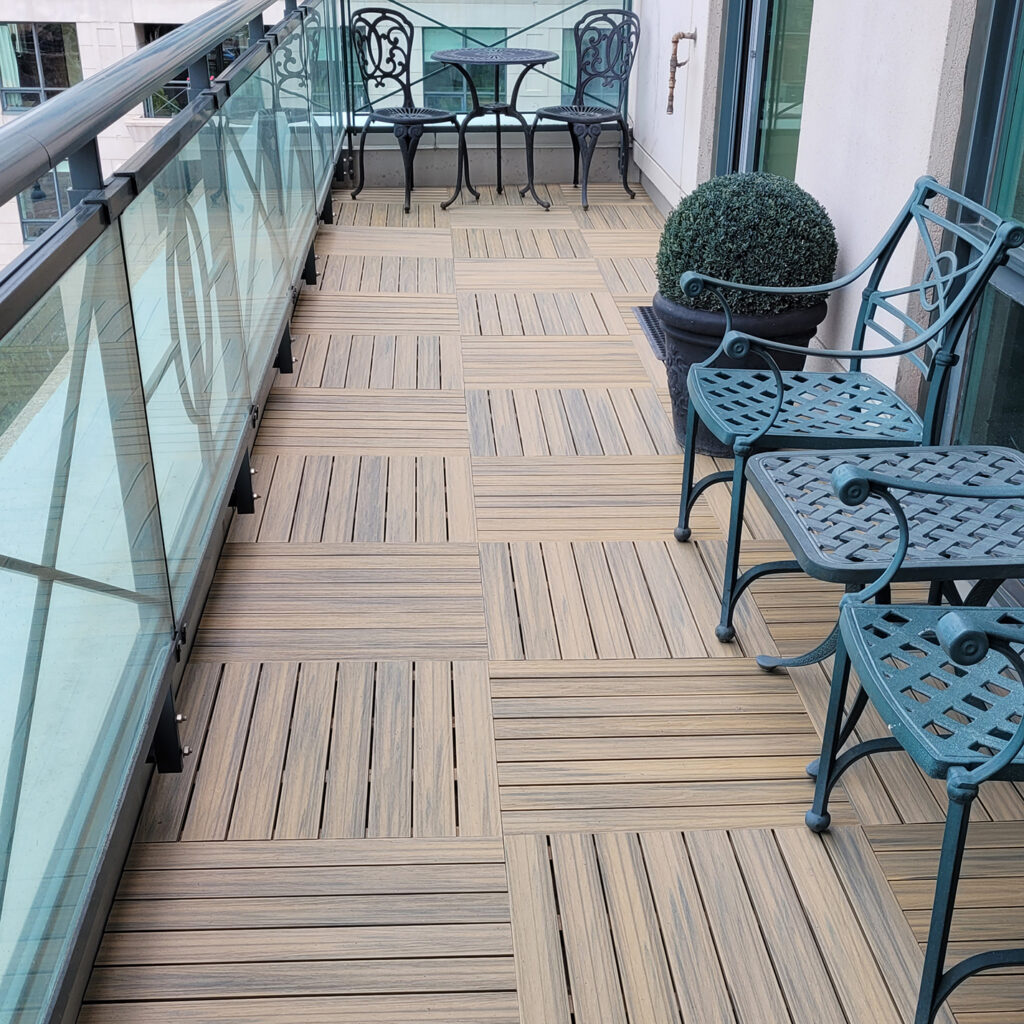
Here are the top 5 applications of wood plastic composite listed below:
1. Decking and Outdoor Flooring
One of the most common applications of WPCs is in decking and outdoor flooring. Wood Plastic Composite is a popular and fully operational alternative to traditional wood decks. It provides excellent resistance to moisture, pests and weather changes. Unlike natural wood, WPC decks do not crack or splinter over time.
The primary reason why people prefer WPC decking is due to its durability and long term performance. Moreover, WPC boards are available in multiple colours and textures to renovate the outdoor spaces and give a visually appealing look to any area. When it comes to installation, WPC decking is designed for ease and convenience.
With simple interlocking systems and lightweight boards, the installation process is hassle-free, making it simple for both professionals and DIY enthusiasts. Decks made from WPCs are a great choice for outdoor flooring and can be installed in areas such as patios, balconies, and gardens.
2. Cladding and Facades
WPC cladding and facades are popular choices for adding both style and strength to residential and commercial buildings. Both of WPC applications, improve the exterior appearance while providing protection against environmental damage. In simple words, cladding is a type of material that covers the exterior of a particular object.
In contrast, a facade refers to the front exterior of a building, typically designed to enhance its visual appeal. WPC panels help a lot in preserving the object from fungal growth, UV rays and other conditions that can damage the deck. The composite material reduces heat absorption, thus improving energy efficiency in buildings.
Unlike traditional wooden cladding, WPC does not require painting or polishing. It is lightweight, making each step of installation effortless and cost-effective for major construction projects. Architects and builders prefer WPC cladding because it enhances the aesthetic value of buildings while offering durability against challenging weather conditions.
3. WPC Fences and Railings
WPCs are also widely used in fencing and railing systems, offering both functionality and a refined appearance. It is a sustainable option rather than traditional wooden fences. It provides shielding against termites and obviously harsh weather conditions. With these features, WPC ensures longevity and reliability of the aesthetic outdoor space.
These fences do not rot, fade or warp overtime. WPC fencing and railings are available in different designs and colours that suit various architectural styles. Furthermore, these systems generally facilitate assured security and privacy for residential properties, commercial complexes, as well as public parks.
4. Stylish and Durable WPC Doors
WPC doors are well-known for their durability, resistance to moisture, and seamless maintenance, making them a reliable choice for various spaces. Unlike wooden doors, they do not swell, crack or deform in humid environments. Like other applications of wood plastic composite, the doors are also resistant to termites and fungal growth, guaranteeing long-lasting durability.
They offer excellent thermal and sound insulation, enhancing comfort in homes and offices. You can choose a variety of styles and finishes available in this category adding a modern touch to the interior and exterior spaces. Apart from this, the material comprises non-toxic properties that make WPC doors a safe as well as eco-friendly choice.
5. Modular Furniture and Cabinetry
Wood plastic composite is widely used in furniture manufacturing as it has water resistant characteristics. This means the furniture stays free from moisture damage and does not require any chemical treatments. Thus, making it ideal for kitchens, bathrooms as well as outdoor settings. WPC material can be molded into various designs, providing flexibility in furniture construction. The cabinetry offers a sleek appearance with smooth finishes that resemble natural wood.
In addition to their durability, WPC pieces require minimal polishing or maintenance. With these benefits, WPCs have become a key material in contemporary construction, valued for their adaptability, longevity, and environmental benefits. Their ability to withstand harsh environmental conditions while maintaining aesthetic appeal makes them a preferred choice for architects, builders, and homeowners alike.
With the increasing focus on eco-friendly and low-maintenance building materials, WPCs are becoming an important part of modern construction.
WPCs Shaping the Dynamics of Modern Construction
Wood Plastic Composites (WPCs) are revolutionizing the construction industry by offering a balance of aesthetics, functionality, and sustainability. Let’s explore how WPCs are influencing modern construction in detail:
1. A Sustainable Alternative
By combining reused wood fibers with plastic, WPCs minimize the need for freshly cut timber. This approach helps conserve forests and promotes sustainable construction practices. By utilizing recycled materials, WPCs also contribute to reducing industrial waste, making them an environmentally responsible choice. Many green building initiatives encourage the use of WPCs as they align with global sustainability goals.
2. Expanding Design Possibilities
Unlike traditional construction materials, WPCs provide greater flexibility in design. They can be shaped into a variety of designs, allowing architects and designers to create intricate and modern structures. Available in a variety of textures, colours, and finishes, WPCs can mimic the appearance of natural wood, stone, or other premium materials. This adaptability makes them ideal for exterior paneling, artistic facades, and modern interior designs.
3. Long-Term Aesthetic Appeal
One of the biggest advantages of WPCs is their ability to maintain their elegant furniture look over time. Natural wood can deteriorate due to environmental exposure, but WPCs remain intact without losing their charm. They are ideal for outdoor applications such as decking, fencing, and facades, as they continue to look fresh and polished without requiring extensive upkeep. Property owners appreciate WPCs because they do not require frequent painting, polishing, or sealing, making them a convenient and cost-effective option.
4. Enhancing Efficiency in Construction
Construction projects often face challenges related to transportation, labor, and material handling. Since WPCs are lightweight, they are easier to handle, transport, and install than materials like solid wood or concrete. This helps cut down on labor expenses and accelerates project completion. Additionally, WPC panels and boards are designed for easy assembly, often featuring interlocking mechanisms that make installation seamless. In large construction developments, this advantage simplifies operations, leading to efficient use of time and resources.
5. Ideal for Urban and Public Infrastructure
WPCs are not just limited to residential or commercial buildings; they are also widely used in urban development projects. Cities and municipalities are incorporating WPCs into public spaces like parks, walkways, benches, and even bus stops. The material provides a modern and stylish look while being able to endure diverse environmental conditions. Because WPCs require minimal upkeep, they are a practical choice for city planners looking for long-lasting and budget-friendly infrastructure solutions.
6. Elevating Interior Spaces
Interior designers are increasingly choosing WPCs for home and office interiors due to their ability to create a sophisticated and contemporary look. Whether used for wall paneling, ceilings, or modular furniture, WPCs offer a luxurious wood-like finish without the need for constant care. Since they can be crafted into various designs, they provide homeowners with personalized and stylish interior solutions.
7. A Future-Ready Building Material
The construction industry is continuously evolving, with increasing emphasis on smart and sustainable materials. With ongoing advancements in material technology, the applications of WPCs are expanding beyond current uses. This paves the way for more eco-friendly, energy-efficient, and aesthetically pleasing constructions in the future.
Final Thoughts
As the construction industry embraces innovation, Designer Deck products are redefining modern architecture with cutting-edge solutions. By integrating WPCs into various applications, they offer a forward-thinking approach that balances style, longevity, and environmental responsibility. From sleek exteriors to practical interiors, this material is shaping modern spaces with durability and sustainability. Our eco-friendly solutions ensure long-lasting structures that evolve with architectural trends.
- Maintenance Tips for Thermory Hardwood Decking
Thermory hardwood decking is a top choice for homeowners and businesses looking for a strong, stylish, and long-lasting outdoor space. Using a special thermal modification process, this decking is moisture resistant, decay and pests proof, making it a low-maintenance option. However, regular care is essential to maintain its beauty and durability. That is why Designer Deck has listed simple steps like frequent cleaning, applying UV protection, to ensure proper airflow. By following the tips the decking stays fresh and in ideal condition for years to come. Below are some easy-to-follow maintenance tips to help you protect and preserve your Thermory hardwood decking.
Key Tips For Maintaining Thermory Hardwood Decking
Proper maintenance ensures that your thermory hardwood decking remains visually appealing and structurally sound for years. To prevent furniture damage, ensure immediate cleanup and monitor moisture levels regularly. Applying UV-resistant oils, managing airflow beneath the deck, and seasonal inspections further contribute to its longevity.
Following these essential care tips will help retain the deck’s natural beauty and durability, allowing you to enjoy your outdoor space with minimal effort. Here are the basic maintenance tips for preserving thermory hardwood decking listed below:
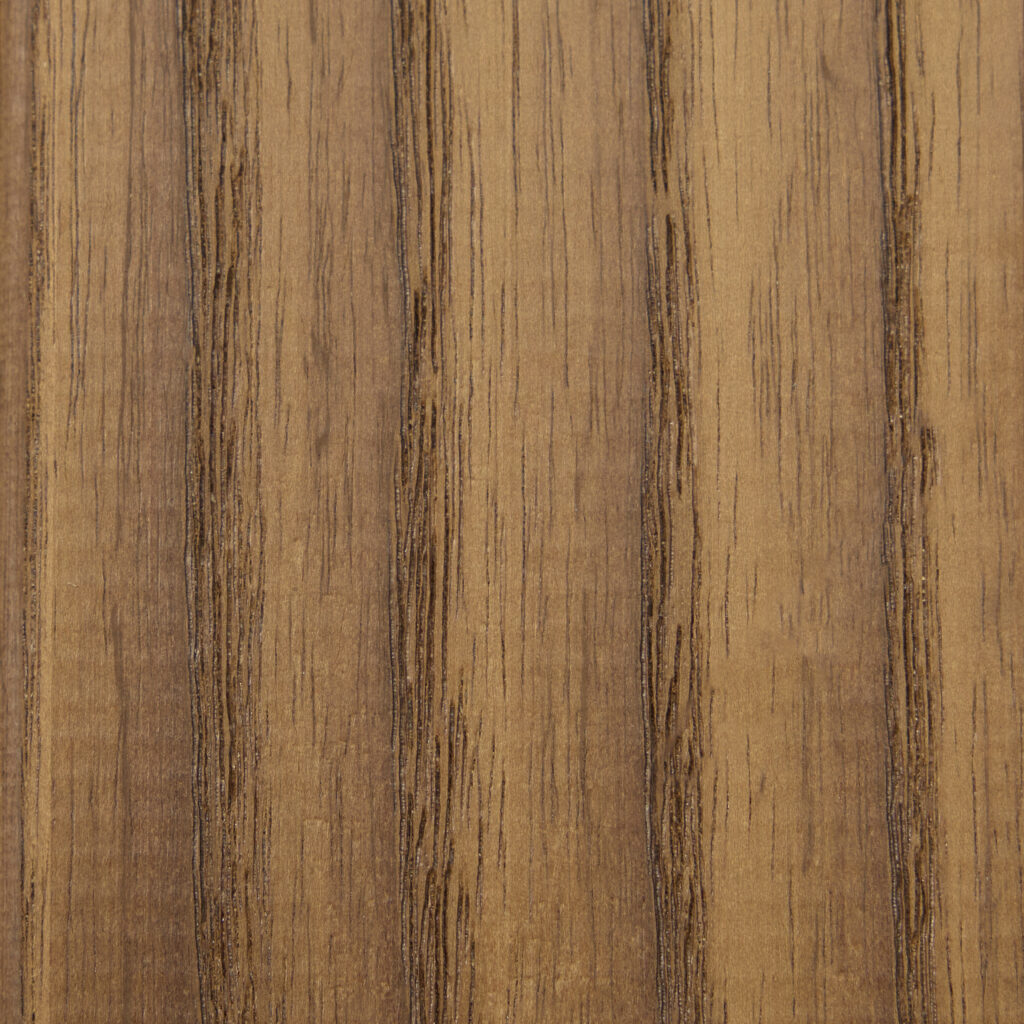
1. Routine Cleaning for Longevity
Keeping your deck free from dirt, dust, and organic debris helps prevent buildup that can lead to stains and potential damage. Sweeping the surface with a soft-bristle broom or using a leaf blower ensures that dust and leaves do not accumulate.
For better cleaning, use a mild soap solution mixed with warm water to effectively lift away dirt and grime. Wipe the surface gently with a soft mop or sponge, then rinse thoroughly to remove any soap residue. Avoid using pressure washers, as excessive force can damage the wood fibers and erode the finish.
2. Protecting Against Moisture and Water Damage
Although Thermory hardwood is designed to withstand moisture better than untreated wood, prolonged exposure to water can still cause minor swelling and fading. To avoid water-related problems, maintain proper drainage around the deck by regularly clearing gutters and downspouts.
After heavy rainfall, remove any standing water using a deck squeegee or dry cloth. If your deck is near a pool or in a humid climate, consider applying a high-quality water-repellent sealant to provide an additional layer of protection against excess moisture.
3. Preserving the Deck’s Natural Colour
Over time, exposure to sunlight causes the deck’s colour to fade, developing a silvery-gray patina. While some homeowners enjoy the naturally aged appearance, others prefer to preserve the original rich tones.
To retain the deck’s vibrant colour, apply a UV-resistant oil or protective finish at least once a year. Before application, clean the deck thoroughly and let it dry completely. Using a natural bristle brush or a lint-free cloth helps evenly apply the treatment, enhancing the wood’s colour while providing added protection against UV rays.
4. Handling Scratches and Surface Marks
Minor scratches and scuffs can occur due to furniture movement, foot traffic, or accidental impacts. To minimize visible marks, use fine-grit sandpaper to gently buff out imperfections, following the wood grain for a smooth finish.
For deeper scratches, applying a small amount of wood oil can help blend the affected area with the rest of the surface. Regularly using furniture pads under chairs and tables can prevent future damage, keeping the deck pristine.
5. Preventing Mold and Mildew Growth
While Thermory hardwood naturally resists mold and mildew, shaded areas or prolonged damp conditions can sometimes promote fungal growth. To reduce this risk, improve ventilation around the deck by trimming nearby shrubs and promoting better airflow.
If mildew forms, mix white vinegar and water, spray it on the affected area, and lightly scrub with a soft brush. Then, wash it away thoroughly with clear water and eliminate remaining dirt. For persistent issues, a commercial wood-safe mildew cleaner may be necessary.
6. Seasonal Maintenance Checks
Changes in weather conditions can impact your decking’s performance. Perform regular seasonal checks to spot any signs of damage or deterioration. Check for loose fasteners, warped boards, or small cracks that may require attention.
During winter, clear snow from the decking using a plastic shovel to protect the surface from damage. Avoid de-icing salts containing harsh chemicals, as they can degrade the wood’s integrity. Instead, opt for calcium magnesium acetate, a deck-friendly alternative.
7. Avoiding Stains from Spills
Food, beverages, and oil-based products can leave unsightly stains on the surface if not cleaned promptly. You can clean spills right away with any cloth to stop them from soaking in and ruining the texture of the decks. Do not use harsh chemicals or bleach-based cleaners, as they can harm the wood by stripping off its protective layer. Therefore, always prefer to use milder cleaning solutions to preserve the wood’s quality as well as appearance.
8. Maintaining Proper Airflow Beneath the Deck
Proper ventilation is crucial to preventing moisture buildup underneath the deck, which can lead to premature decay. Ensure that the space beneath remains clear of debris, and avoid placing impermeable materials like plastic sheets directly on the ground.
If your deck is installed close to the ground, periodically check for any trapped moisture and adjust airflow as needed. This simple step can significantly extend the deck’s lifespan.
9. Reapplying Protective Coatings
To maintain durability, reapply a protective finish on the thermory hardwood decking every one to two years. This helps maintain the deck’s appearance while making it capable of withstanding weather conditions.
Before reapplying a finish, sand the surface lightly to remove old coatings and allow better absorption. Adhere to the manufacturer’s guidelines for correct application to achieve optimal results.
10. Choosing Suitable Outdoor Furniture and Rugs
Use outdoor furniture with non-rusting feet and place breathable outdoor rugs to prevent trapped moisture. Avoid plastic or rubber-backed mats, as they can cause discoloration and retain moisture. Opt for rugs made from natural fibers like bamboo or woven polypropylene that allow airflow while adding aesthetic appeal.
To Wrap It All Up,
Caring for your Thermory hardwood deck is a straightforward process that ensures its longevity and timeless appeal. With regular cleaning, moisture control, UV protection, and prompt attention to minor damages, you can keep your deck looking pristine for years. By following these maintenance tips provided by Designer Deck, you not only enhance its aesthetic value but also protect your investment, making outdoor space a lasting source of comfort and enjoyment. Whether you’re aiming to refresh your home exteriors or elevate your surroundings, our premium products and expert advice will help you create a beautiful and relaxing space.
- Smart Outdoor Ambient Lighting: Control Your Atmosphere with Technology
Need smart home solutions to enhance your outdoor spaces? Why not try ambient lighting technology? It is one of the rapidly evolving innovations preferred by most people to glow up the home exterior including balconies, patios, gardens and terraces. To transform your open air area into a cozy luminaire setup, Designer Deck has so much to offer you. Our products deck strip lighting or inground pot lights create a dynamic, customizable atmosphere with a spectrum of colours adding a vibrant touch to every corner. Let’s further reveal more innovative solutions that blend style, functionality and energy efficiency to make your outdoor space aesthetics and shine truly.
Lighten Up Your Outdoors With Ambient Lighting
If you are looking for effective lighting options that combine modern technology with sleek design to elevate any outer space, then ambient lighting by Designer Deck is truly recommendable.
Our LED lights add a cozy glow, making your outdoor space ideal for social gatherings or peaceful nights under the open sky. Also, the subtle glow and exquisite features of reflecting light makes the home environment look more beautiful and welcoming.

Key Features of LED Ambient Lighting
To well-lit the outer or free spaces, ambient lighting is perfect for elevating the look of the exterior. It is a new technology and is sometimes also referred to as general lighting. That is usually considered as the primary source of light in a particular room, or any other space.
The lights overall provide illumination wherever they are fixed and make a big difference by setting a unique tone for the outdoors. Here are the key features listed below:
1. Versatile Lighting Choices
You can choose from a complete RGB spectrum or warm white light to match any setting or your personal choices. Our lighting offers pre-programmed effects and adjustable brightness, giving you the flexibility to create dynamic or gentle lighting as needed.
2. Advanced Control Options
With our short-range remotes and intuitive smartphone apps, you can easily adjust lighting settings, switch colors and manage brightness.
3. Lasting Brightness
Our LED lights use less power while providing steady brightness, helping you lower electricity costs.
4. Specially Built for the Outdoors
The lights are designed with waterproof electrical housings and are able to handle varying weather conditions. Thus, ensuring durability as well as safety all year round.
Smart Home Lighting Offered By Designer Deck
Our collection brings you innovative solutions to brighten up your exterior with style and proper functionality. Our product range includes smart LED strip lighting and in-ground pot lights, that add vibrance to outward areas.
1. LED Strip Lighting
The LED strip lighting adds a refined touch to decks, patios, balconies, gardens, and any other outer space. These strips can be installed along edges or under railings, creating a seamless and modern look.
Moreover, due to the dynamic illumination effects and availability of various color options you can set the perfect ambiance, from vibrant, energetic to calm and soothing.
2. In-Ground LED Pot Lights
For those who prefer a more understated yet impactful lighting option, our in-ground LED pot lights are ideal. Strategically place these lights along pathways, stairways, or around your outer space to highlight specific areas.
You can also ensure safety with lights specifically at night while walking in a lawn. These lights also serve as a practical alternative to strip lighting in spaces where installation might be challenging or not possible.
Both of these lights offer several benefits by transforming exterior infrastructure into a joyful and visually appealing experience.
Benefits of Smart Outdoor Ambient Lighting
Outdoor lighting does more than just brightening up your space, it enhances functionality, security, and aesthetics. By incorporating smart lighting solutions into your outer setup, you create a harmonious blend of beauty and practicality. Here’s how:
1. Enhancing Your Outdoor Living Experience
A well-lit outdoor space can extend your living area, making it usable even after sunset. Whether you enjoy spending time on your patio, hosting barbecues, or simply spending time in the balcony after a long day, this vibrant lighting ensures a warm and welcoming atmosphere.
2. Increased Security and Safety
These lights not only make your space look beautiful but also brighten up dark areas, making it easier to see at night. Pathway lighting helps prevent trips and falls, ensuring safe and comfortable movement for everyone.
3. Customization at Your Fingertips
Smart lighting allows you to create customized illuminating scenes for different moods and occasions. Whether you need a romantic glow for a date night or a vibrant setup for a party, you can adjust the settings effortlessly through an app or remote.
4. Elevating Your Home’s Appearance
Well-placed lighting enhances the beauty of your home’s exterior. If you are planning to sell your house or simply want to take pride in its appearance, smart outdoor lighting adds elegance and sophistication, making your home stand out beautifully at night.
5. Stress-Free Installation and Maintenance
Our great lighting solutions are designed to be easy to install and require minimal upkeep. Designed to endure outdoor conditions, these lights are waterproof and durable, requiring minimal upkeep while delivering reliable performance.
Though these lights are easy to install, you must follow some useful tips to fix the product in a well-defined manner.
Installation Tips for Outdoor Smart Lighting
Setting up outdoor smart lighting is easier than you might think. By planning ahead, you can easily install a lighting system that not only looks great but also serves a practical purpose. Here are some key installation tips:
1. Selecting the Best Spots for Lighting
Identify key areas where lighting is required, such as walkways, seating zones, or landscape features. This helps create a balanced lighting effect without over-illuminating the space.
2. Ensuring Safe and Secure Wiring
To prevent electrical hazards, make sure all wiring is properly secured and protected from weather conditions.
3. Varied Lighting Options
Mixing various lighting styles, such as spotlights, strip lights, and in-ground pot lights, can enhance the visual appeal of your outdoor area. Layering light sources adds depth and dimension to the design.
For any assistance or questions regarding the seamless installation of lighting products, feel free to reach out to the Designer Deck team for helpful tips.
Final Thoughts
Smart outdoor ambient lighting can completely transform the look and feel of your home’s exterior, making it more inviting and functional. Designer Deck provides high-quality and energy-efficient lighting solutions, you can easily create a mesmerizing ambiance that suits your style and functional needs. Whether you want to highlight landscaping, improve safety, or simply enjoy a cozy evening under the stars, our lighting products offer the perfect blend of technology and aesthetics.
- Maintenance Tips for Outdoor Grass Tile Inserts: Keeping Them Fresh and Green
Everyone loves to spend leisure time in outdoor spaces, enjoying the fresh air and natural surroundings. To enhance outdoor spaces, grass tiles are the best option. These are rubber tiles upon which a top artificial grass is applied. Inserting grass tiles brings a refreshing and natural touch to any space, providing a lush, green look without the hassle of maintaining a real lawn. These tiles require minimal maintenance when applied to patios, balconies, and gardens. But still, keeping the grass tiles neat and clean with time is essential. With the right care, the grass tile inserts can stay vibrant and fresh for years, thus uplifting the beauty of any outdoor setting.
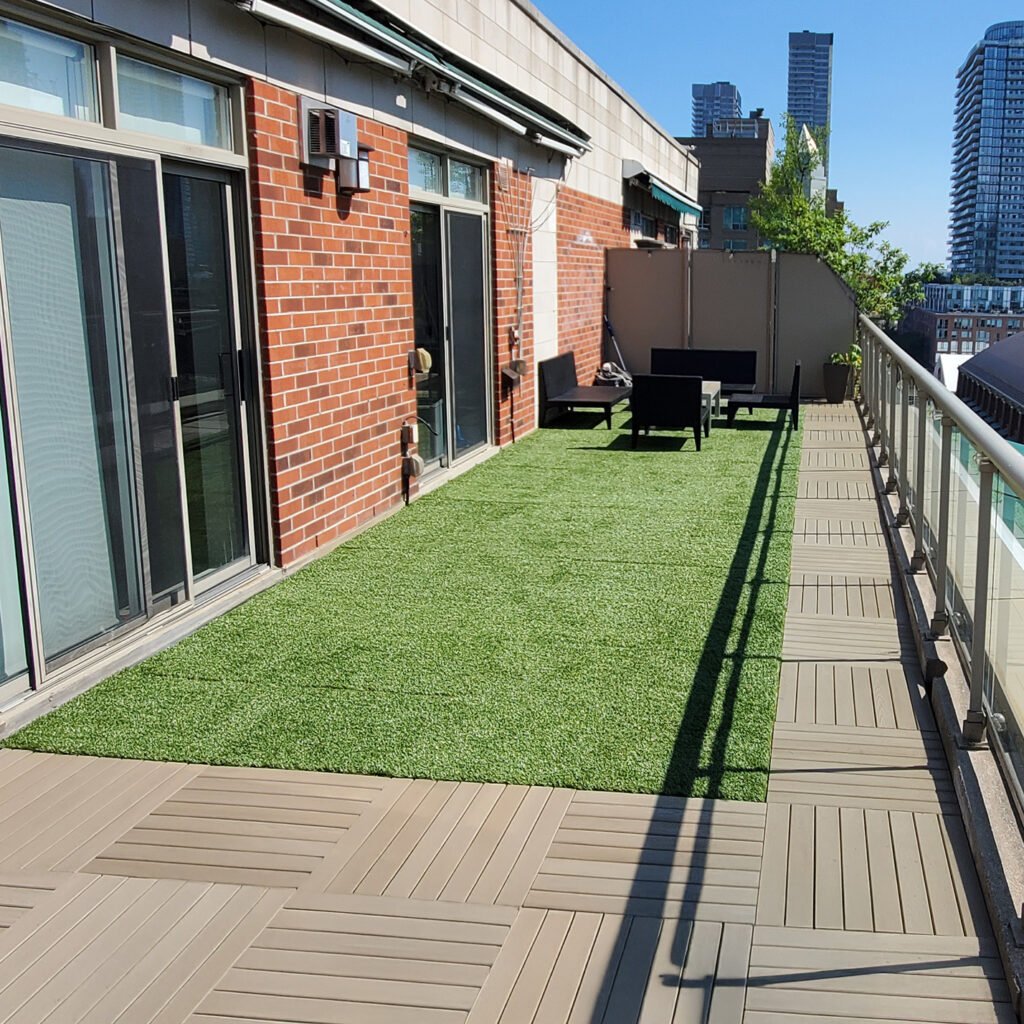
Easy Tips To Keep Your Outdoor Grass Tile Inserts Fresh, Neat, and Clean
Grass Tile inserts are the finest option to renovate patios, balconies, and garden of your home. However, to keep it fresh, neat, and clean, you must maintain the grass tiles by regularly cleaning them, lightly brushing them, and so on. Here are some easy and practical tips to keep up the freshness and cleanliness of your outdoor grass tiles.
1. Regular Cleaning and Brushing
The outdoor grass tiles often get filthy due to dust, and fallen leaves. To maintain a proper as well as fresh look, use a soft broom or brush and vacuum occasionally. Make sure to avoid hard brushing to preserve the grass fibers. By hard brushing it can damage the rubber grass tiles.
- Clean using a soft brush – Clean the surface of tiles to remove dirt and debris.
- Vacuum occasionally – A vacuum cleaner with a gentle setting can help remove deeper dust.
- Avoid hard brushing – To keep your grass tiles in a good look for the long term, avoid hard brushing as it will damage the fibers.
By brushing the grass inserts at least once a week, you can keep them looking neat and natural.
2. Rinse with Water to Remove Dirt
Sometimes what happens is, simple brushing is not enough due to stubborn dirt or mud stuck in the fibers. If you notice filth or stain, you can rinse it with water to clean the dirt.
- Use a hose – To remove dirt, gently spray water by using a hose that is a long rubber tube used to water plants, car wash, or other processes.
- Avoid high-pressure washers – While washing the grass fibers make sure to avoid high-pressure washers as they may damage the look of the product.
- Dry naturally – Allow the water to drain properly and let the grass tiles dry naturally. It will prevent the unnecessary growth of mold or bad odors.
Moreover, a monthly water rinse will help maintain the fresh appearance of your outdoor grass tile inserts.
3. Prevent Weeds and Moss Growth
Even though artificial grass does not grow like natural grass, weeds, and moss can still develop in between the tiles. To prevent it apply a weed killer, remove weeds manually, and ensure proper drainage.
- Apply weed killer – Use a mild, eco-friendly solution every few months to prevent the growth of weeds. You can either use vinegar, baking soda, salt and water, solarization, or other processes to kill weeds.
- Remove weeds manually – If you see small weeds, pull them out before they spread.
- Ensure proper drainage – Make sure to drain water properly to prevent moss growth. So always check that water does collect on or between the tiles.
Checking regularly or washing the tiles occasionally, will keep the grass tiles looking fresh and stay maintained.
4. Protect from Heavy Furniture or Walkways
If you have furniture or walkways over the grass tile inserts, then you need to prevent damage by using furniture pads. Also, you can maintain grass tiles by rotating furniture positions and so forth.
- Use furniture pads – By placing rubber or plastic pads under table and chair legs, it can reduce pressure on the grass. Hence, keeping the grass tiles look fresh and in good appearance.
- Rotate furniture positions – If you are facing the problem of permanent flattening of the grass fibers, then simply rotate the furniture positions. With this you can easily maintain the structure of rubber grass fibers.
- Brush the fibers – Whenever you notice that the grass is flattening, simply use a soft brush to lift the fibers back up.
This will surely help you in maintaining the original look and feel of your outdoor grass tile inserts.
5. Remove Stains and Spills Quickly
Outdoor spaces are the voids of memories and are full of cheerful environments created by family members, get-togethers, and parties. And, it is common that while enjoying nature or partying together, the beverages can spill on the grass tiles thus leaving a stain. You can clean stains by using a clean cloth, mild detergent, and gentle scrub.
- Use a clean cloth – For water-based stains such as juice, coffee, and other drinks, blot with a clean cloth and then rinse with water.
- Mild detergent – You can use mild detergent and gently scrub the area with oil-based stains of grease, makeup, etc. are present.
- Avoid harsh chemicals – Stop using bleach or other strong chemicals that can discolor the grass fibers.
Cleaning spills immediately will prevent long-term stains and maintain the aesthetic look of grass tile inserts.
6. Manage Pet Waste and Odors
If your pets use the outdoor space, then proper cleaning is necessary to keep up the good appearance of grass tiles and odor-free.
- Clean the waste quickly – Dispose of the pet waste as soon as possible to keep the area neat and clean.
- Rinse with water – Spray the affected area with water to clean the residues.
- Use a mild deodorizer – A pet-friendly cleaner can help remove the odors.
Furthermore, cleaning the surface and residue will ensure a fresh-smelling outdoor space and grass tiles.
7. Importance of Proper Drainage
Good drainage is vital for ensuring the longevity and durability of outdoor grass tiles. To ensure proper water drainage, check the base layer, clean drainage holes, and avoid overwatering.
- Check the base layer – Must ensure that the tiles are installed on a well-draining surface.
- Clean drainage holes – Remove any dirt or debris blocking water flow. This will prevent the growth of unnecessary weeds.
- Do not over water – You should avoid over watering as it can cause mold and bacteria buildup. Therefore, avoid overwatering to preserve the good appearance of the grass tile inserts.
Additionally, proper drainage ensures good hygiene and generally increases the durability of your grass tiles.
8. Shield Against Harsh Weather Conditions
Extreme weather conditions can affect the appearance and lifespan of outdoor grass tile inserts. Provide shade in summers, proper drainage during the rainy season, and use plastic shovels to remove snow during winters.
- During hot weather – To maintain the long-term durability of grass tile inserts, then provide shade or spray water occasionally to prevent overheating.
- Prevent Water Pooling – Ensure proper drainage during the rainy season to avoid water buildup.
- Snowy Weather – Avoid using metal shovels to remove the snow, instead prefer plastic shovels or brush off the snow gently.
Taking precautions for different weather conditions will keep your tiles looking fresh and protected all year round.
9. Select the High-Quality Grass Tile Inserts
Select the High-Quality Grass Tile Inserts To value your time and money, choosing the right materials for outdoor grass tile inserts is crucial. Therefore, Designer Deck has got you covered and offers synthetic grass with rubber backing, grass with feathered PVC as well as wood backing for a classic look.
- Synthetic Grass with Rubber Backing – We offer cryogenic rubber infill that utilizes 100% recycled tires, good for excellent cushioning and durability. Also, there is a great use of recycled materials, making grass tile inserts makes this an eco-friendly choice.
- Grass with Feathered PVC – The grass with feathered PVC provides a natural appearance and realistic grass-like look, enhancing the aesthetic appeal of outdoor spaces.
- Wood Backing – We provide partly air-dried grade 2 wood that comprises spruce as well as pine mixture, ensuring strength and longevity.
Conclusion
Outdoor Grass tile inserts are perfect to elevate the spaces where you spend leisure time. To keep them fresh, neat, and clean, regular care is mandatory. Simple practices such as brushing, rinsing with water, preventing weeds, and protecting from harsh weather conditions can make a big difference. Designer Deck is an expert in transforming your outdoor spaces and exterior furniture designs with quality tiles crafted out of the right and durable materials. Book a consultation with our team to elevate your outdoor spaces and customize your designs.
-
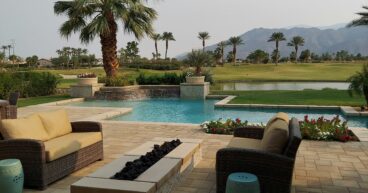 04Dec
04Dec
Mix N’ Match Deck Tile Ideas for Patios, Balconies, and Terraces
Are you in search of custom mix n’ match deck tile ideas? Do you want to renovate your outdoor spaces in a modern way by… Read More →
-
 24Nov
24Nov
Innovative Decking Solutions: Why Modular Deck Tiles Are the Future
Need a modern approach for your outdoor flooring? Are you looking forward to innovative decking solutions that are easy to install and last for a… Read More →
-
 15Nov
15Nov
Enhancing Your Home’s Aesthetics with Thermory Hardwood Cladding
Thinking about giving your home’s exterior a fresh new look? When it comes to home design, the exterior matters just as much as the interior… Read More →
-
 08Nov
08Nov
Holiday Decorating Ideas for Small Deck Spaces
Planning to spend the holidays at home? Need creative ideas to embellish patio or deck spaces for a holiday retreat? Small deck spaces though limited… Read More →
-
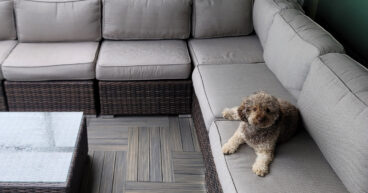 01Nov
01Nov
Designing a Pet-Friendly Balcony Using Durable Deck Tiles
Thinking of upgrading your outdoor nook into a pet-friendly space? Pets are our best friends, and caring for these companions is truly a genuine expression… Read More →
-
 26Oct
26Oct
Pressure-Treated Narrow-Board Wood vs. Composite Decking: Making the Best Choice for Your Deck
Selecting a decking material is an important decision that impacts the durability, maintenance, and overall look of your outdoor space. Homeowners often consider pressure-treated narrow-board… Read More →
-
 16Oct
16Oct
Top 5 Applications of Wood Plastic Composites in Modern Construction
Wood Plastic Composite (WPC) has entirely transformed the scenario of modern construction due to its durability and low maintenance requirements. The composite material combines wood… Read More →
-
 10Oct
10Oct
Maintenance Tips for Thermory Hardwood Decking
Thermory hardwood decking is a top choice for homeowners and businesses looking for a strong, stylish, and long-lasting outdoor space. Using a special thermal modification… Read More →
-
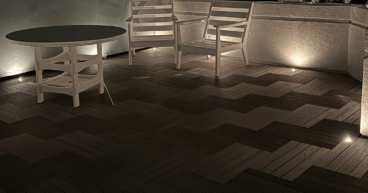 02Oct
02Oct
Smart Outdoor Ambient Lighting: Control Your Atmosphere with Technology
Need smart home solutions to enhance your outdoor spaces? Why not try ambient lighting technology? It is one of the rapidly evolving innovations preferred by… Read More →
-
 26Sep
26Sep
Maintenance Tips for Outdoor Grass Tile Inserts: Keeping Them Fresh and Green
Everyone loves to spend leisure time in outdoor spaces, enjoying the fresh air and natural surroundings. To enhance outdoor spaces, grass tiles are the best… Read More →
-
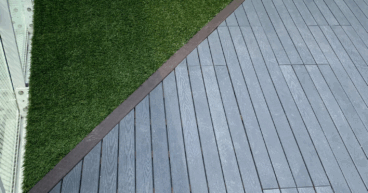 19Sep
19Sep
Enhancing Urban Spaces with Grass Tile Inserts: A Trend Towards Greenery
Are you looking forward to enhancing urban spaces that are both sustainable and visually captivating? As cities continue to expand, the dominance of concrete and… Read More →
-
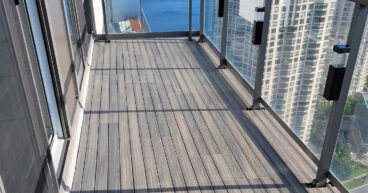 14Sep
14Sep
Cost Analysis: Is Investing in Wood Plastic Composite Worth It?
When upgrading your home or outdoor area, selecting the best material is vital. From traditional wood to vinyl, countless options are available, but one material… Read More →




